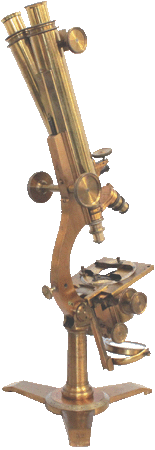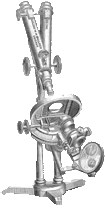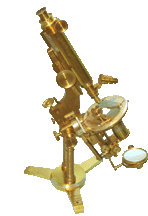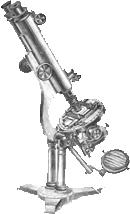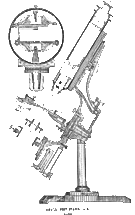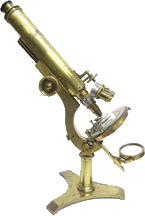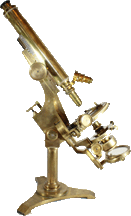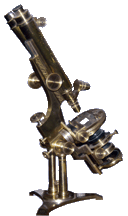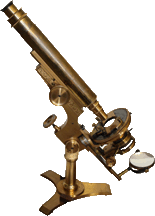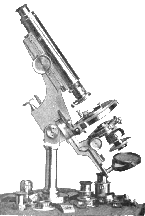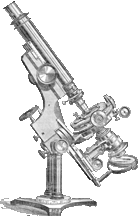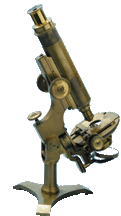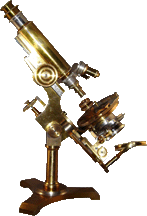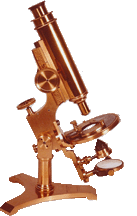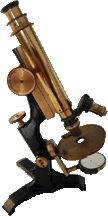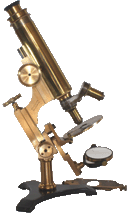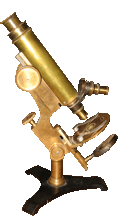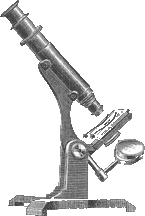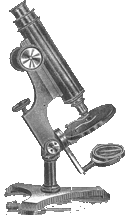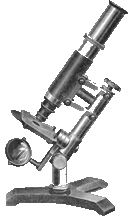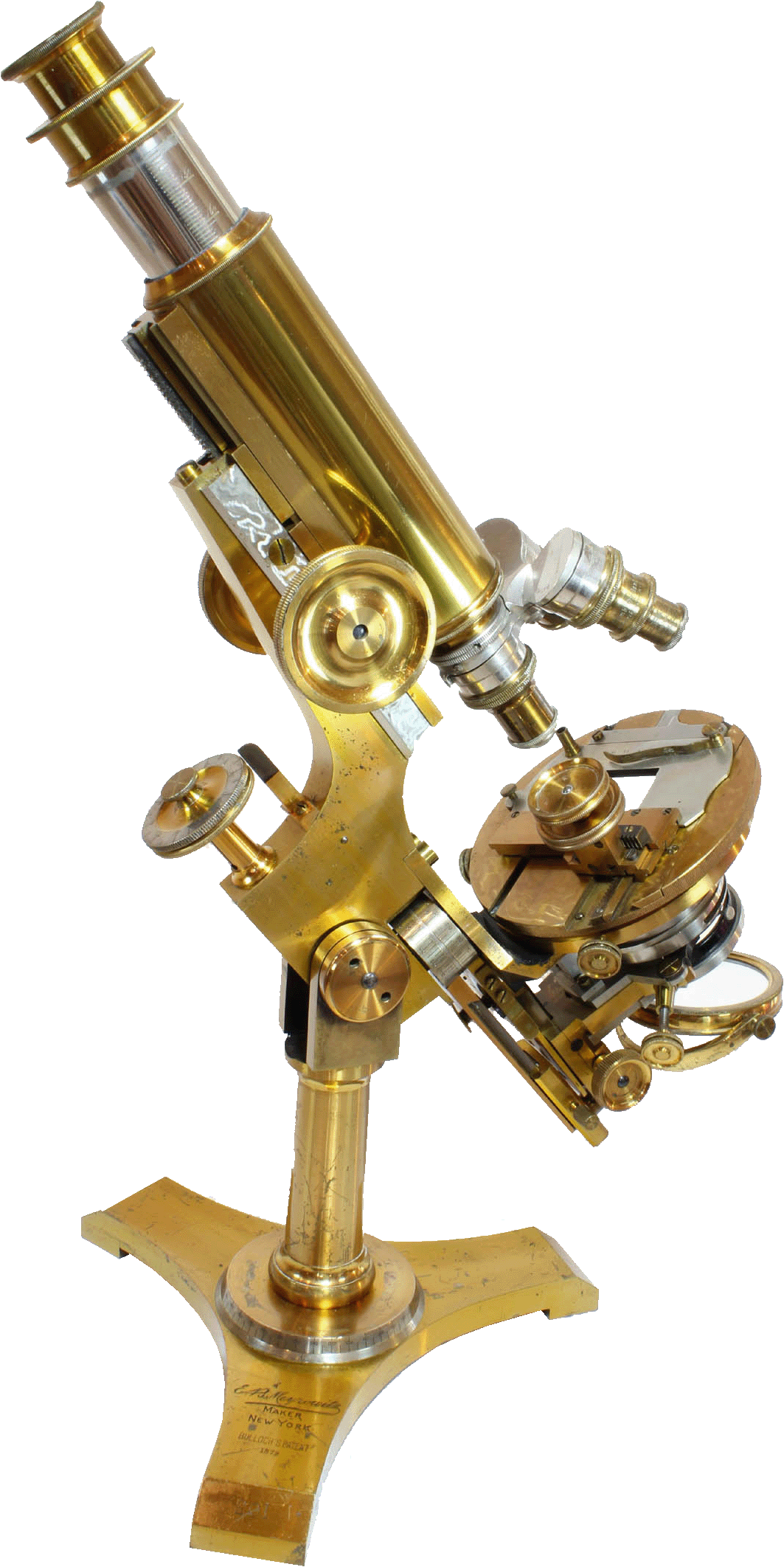MICROSCOPE-ANTIQUES.COM © 2013-22.
BULLOCH MICROSCOPES:
STANDS MADE BY WALTER H.
BULLOCH AND SUCCESSORS (1870's TO c. 1895)
This is a page devoted to the various microscopes made by the
famous American Maker, Walter H. Bulloch. Its content attempts to
picture and describe, to the extent known, as many models of Bulloch Microscopes as possible. In addition, where available, the author has attempted to show the evolution of these instruments, i.e. changes in certain models. This has been a challenge because there are only two known catalogs (1878 and 1890) plus scattered publications and advertisements. Furthermore, no engravings or illustrations of earlier Bulloch microscopes seem to exist. Because of the Internet, sales of previously unknown or
little known examples of his work have revealed some additional
information, and when possible the information derived therein is
included. Furthermore, thanks to the kindness of many collectors and photographers, the author has had the privilege of personally inspecting many of these instruments. The work was made more difficult in that Bulloch did not always place serial numbers on his stands and also did not always sign them. Even more misleading, sometimes serial numbers and patent dates
were not in the usual location (on the top of the foot), but were
elsewhere, such as the underside of the foot or the underside of the stage; some microscopes on record as 'unsigned' may actually have this information 'hidden' in such an unusual location. Another confusing point are the serial numbers of certain instruments sold by Meyrowitz, his New York agent and later successor, as these stands had later features than
the higher serial-numbered stands; this is discussed in more detail below. When available, links are provided to pages describing the Bulloch microscopes described in more detail on this website, and elsewhere; some of the Bulloch stands pictured on this website in detail belong to other collectors who have been kind enough to share them with you. The information contained herein then is likely incomplete, but is improving all the time. I hope it provides more information in one place than was easily available before. I would
welcome any additional information to improve these pages. The
following table allows you to jump to a particular model without
scrolling through the entire page, simply click on a picture to do so.
Please keep in mind that identification of certain stands may depend on
minor or subtle differences-see the discussions below for details and
follow the respective links. Also keep in mind that in the case of some
models, no engraving or photograph was available at the time this page
was last updated. In these cases only descriptions are noted.
Of
the 24 different models shown here, I have been able to locate extant
examples for only half of them.
Walter Bulloch's microscopes were reviewed and pictured in the various Journals and Books of the times, including the JRMS. Bulloch designs were highly respected, and his Biological model was copied and sold in the 1880's by the London firm of Watson & Sons as the Watson-Bulloch Biological microscope.
For an updated history of Bulloch microscopes see here.
For a tabular chronology of Bulloch's locations(cities) and work (alone
or working for someone else or with someone else), see the Bulloch Chronology Page.
For a partial listing of Bulloch instruments with known
serial numbers see the
Bulloch Microscope Serial Number Page.
EARLY STANDS

Records from a Chicago Business directory indicate that Walter Bulloch was working in Chicago from no later than 1867, and he stated it was since 1866. No records which enable the dating of signed Bulloch microscopes between 1866 and the Great Chicago fire of October 1871 seem to exist. After the fire, he left to go work with Tolles in Boston and returned about 1872. The earliest known Bulloch advertisements (1868) do not show illustrations and do not describe his microscopes in detail. A reference in the RMS Journal, of 1880, vol III, p 1067 states that he was making his 'Sector' Model from 1873. The serial number on the engraving of that stand is 52. In 2022, we became aware of, and acquired, number 32(left). Number 32 is a binocular compound microscope closely resembling higher class microscopes sold by Pike in the 1870's. This is no mere coincidence since when Bulloch left Pike, he was their foreman. As discussed on the page describing this microscope, it is likely that the date of construction of this microscope predates the Great Fire of October 1871.
The Congress was made from about 1877. These are the earliest stands for which there are good descriptions and indeed an
engraving.
Bulloch's earliest known surviving stands have been identified in most
cases by their signature, and by engravings in publications. Bulloch
did not hold patents on his earliest instruments. His first patent, in
1879 was for a microscope with separate swinging substage mirror and
condenser tailpieces; the microscope pictured in the patent drawing had
a long lever micrometer screw focus. Neither of these features were
present on his earlier microscopes pictured in early ads, but were
present in the engravings of the 1878 catalog. There were frequent
delays in publications in the 19th century, which can lead to some
confusion as to dating Bulloch stands. One of the earliest Bulloch
Microscope ads was for the 'A' stand in the 1879 edition of the
American
Journal of Microscopy and Popular Science. This stand is pictured in
the 1878 Bulloch catalog as his 'Small Best Stand'
and indeed was his third rate stand after the A-1, and the A B.
Bulloch was famous for constantly changing his designs, and therefore, as time
passed his microscopes changed. Sometimes these changes were minor and
subtle, such as a change in the shape of the foot, or more significant,
like the use of a saddle fitting to support the stage, starting about
1877.
Some of his early stands were given letters, (A1, AB, A, B, C, D, E, and F) with the exception perhaps of the 'Sector Microscope' . For a
while he combined the letter designation with names, e.g. the 'A 1 Congress.'
LATER STANDS
By the time he died, Bulloch stands had evolved to incorporate his
latest design changes, including the dual-swinging tailpieces,
long-lever fine focus, mechanical stage with controls projecting
upwards and allowing full rotation, and eventually, a rack and pinion
control for the mirror height, the latter being a feature not seen on
any other stands that I am aware of. His stands continued to
be produced after his death, initially by Van Mehrens, and
supposedly by
Meyrowitz in New York (see below). Bulloch's later stands
were given names instead of numbers (Congress, Professional,
Professional No. 2, Biological No
1, Biological No 2, Histological No 1, Histological No 2, Student, etc).
DESIGNATIONS OF THE VARIOUS STANDS
As noted, Bulloch's
early stands were named with letters and in some cases with a
number attached. His
biggest and best stand was referred to as the 'A 1'; there were then
stands lettered AB and A through F with the F stand designated as the
Student Stand. Later models had names and in some cases a
number
(No.). Unlike some other makers who called their best
microscope
'No.1' and second best 'No 2,' Bulloch used these as a chronological
designation of different models; hence
the Biological was followed by the later but more complex Biological No
2, and the Professional, was followed later by the less complex
Professional No 2. In addition, some earlier versions of some
stands
were retained, (hence the original 'New' Biological was renamed to the
'Biological No 1'), and in some other instances a completely different
stand replaced it; an example of this is the 'Student' stand which had
at least 4 versions, apparently none made at the same time as the
others; another example is the large Professional which was at first a
single-pillared stand and then, of the same size, but double-pillared.
It is notable that unlike the case for the Biological and
Histological models, Bulloch never called his bigger more complex
Professional Model the No 1. There was simply a 'Professional' and a 'Professional No 2'. This may have to do with the fact the the
'Professional' was initially a large single pillar instrument, and
changed later to a 2-pillar instrument; this would lead to some
confusion if the two pillar instrument were numbered, as it was
technically the second version of the large Professional model. Since the single-pillar version was at the time of the double pillar model
obsolete, just like in the case of the Student stands, there was no
need to have designations for an instrument no longer made, and
referring to the new version of the Professional as the Professional No 1 would not have been consistent with his practice of using those
numbers chronologically. Lastly, Meyrowitz, initially an agent for Bulloch, continued to sell his type of microscope after Bulloch died. During this time they modified the designs a bit(most importantly to change his straight rack and pinions to spiral), and they renamed his Biological No. 2 the 'Bulloch Bacteriological' model. Any Bulloch microscope with a diagonal rack can be assumed to be a Meyrowitz product, produced after Bulloch had died.
MEYROWITZ STANDS PRODUCED AFTER BULLOCH'S DEATH
There are a group of microscopes, produced and/or modified
after Bulloch's death, which incorporate features which Bulloch never
used during his lifetime. These stands are documented on the Main Bulloch Serial Number Page and also on a page devoted just to the meyrowitz signed stands. These stands are
usually signed with the words 'Meyrowitz, Maker, New York' and 'Bulloch Patent.' These were clearly sold after Bulloch died in November of 1891. They usually incorporate angular or 'spiral' rack and pinion controls (which Meyrowitz stated was one of their modifications to Bulloch's designs). There are also two different microscopes with the serial number 201, again suggesting two different runs of serial numbers. Furthermore, number 112 and number 117 have too low a serial number to have been made in sequence with other Bulloch stands because they are the Histological model, a form not produced until sometime after 1880, not shown in the 1878 catalog, not mentioned in the 1879 price list in Frey's book, and certainly not in the same time period as other stands in this serial number range. For example, serial number 132, an older form of Professional, was no longer made when the Histological was introduced.
Please click on the illustrations for enlarged images and, in some
cases, more information!
NUMBER 32 (c 1872(?)

This example, with the lowest serial number I am aware of (as of December 2021) is not pictured nor described in any publication that I am aware of. Remembering that Bulloch worked for Pike for many years, we note that this stand strongly resembles one of the Pike models of the 1870s. The differences include the flat equilateral tripod with single pillar, as the Pike was mounted on a Y-shaped tripod with two flat uprights. It is likely that before Bulloch developed his own designs, he based his stands on other models likely including the ones he knew so well from working for Pike.
THE 'SECTOR MICROSCOPE' (c 1873-1877(?) )

This model was described in the JRMS, vol 3 of 1880 pp1067-1068, shown
in figure 133, page 1068, but again, was an out of date description, as
it is not shown nor described in the 1878 Bulloch Catalog. The article
states it was first exhibited in 1873. I am unaware of any surviving
example of this stand. I note the engraving shows serial number 52,
which might help date that number to 1873 (?).
THE 'LARGE BEST A1 CONGRESS' OR SIMPLY 'CONGRESS' (1877-1891, in
various versions).
 The first version of the Congress was at first called the 'First Class
A1' or 'Large Best Stand-A1' according to the 1878 Catalog. According
to RMS publications, it was first made in 1877. The term 'Congress' was
used by Bulloch sometime following the Microscopical Congress, (of
which Bulloch was a member), after their meeting in August of 1878.
Over the years, certain features changed. Although the first version
was produced in 1877, his patent for these instruments was that of
1879. These large stands marked the beginning of his trademark double
swinging tailpieces, one for the mirror and one for the condenser,
which could be moved together as a unit or separately. Another feature,
not in the initial model, which Bulloch felt was very important, was
that the rotation mechanism for the tailpieces was separated from the
stage itself which was supported by a 'saddle fitting.' This feature
was not part of the early Congress models, which had the stage in
contact with the axle through which the tailpieces rotated. By
separating the stage on a saddle, he felt this minimized any vibration
or displacement of the stage that other maker's tailpieces would have
caused had they been moved with a specimen on the stage. Initially used
on the A1-Congress, 'Congress Junior,' and 'A B' ('Diatom')stands,
these features, a saddle fitting, and dual tailpieces, were later found
on the 'Professional,' 'Professional No 2,' 'Biological No 1,' and
'Biological No. 2' Models. Some of the 'Student' models had a saddle fitting as well. These features were not found on the 'B',
'C', 'D', 'E', 'F', 'Histological', 'Physician's', 'Bulloch-Bastin' stands.
A feature limited to only the Congress and the Professional
stands was an angled extra support to the saddle piece for added
rigidity; this is not present on the early version shown in the
engraving, as it did not have the saddle piece either.
The first version of the Congress was at first called the 'First Class
A1' or 'Large Best Stand-A1' according to the 1878 Catalog. According
to RMS publications, it was first made in 1877. The term 'Congress' was
used by Bulloch sometime following the Microscopical Congress, (of
which Bulloch was a member), after their meeting in August of 1878.
Over the years, certain features changed. Although the first version
was produced in 1877, his patent for these instruments was that of
1879. These large stands marked the beginning of his trademark double
swinging tailpieces, one for the mirror and one for the condenser,
which could be moved together as a unit or separately. Another feature,
not in the initial model, which Bulloch felt was very important, was
that the rotation mechanism for the tailpieces was separated from the
stage itself which was supported by a 'saddle fitting.' This feature
was not part of the early Congress models, which had the stage in
contact with the axle through which the tailpieces rotated. By
separating the stage on a saddle, he felt this minimized any vibration
or displacement of the stage that other maker's tailpieces would have
caused had they been moved with a specimen on the stage. Initially used
on the A1-Congress, 'Congress Junior,' and 'A B' ('Diatom')stands,
these features, a saddle fitting, and dual tailpieces, were later found
on the 'Professional,' 'Professional No 2,' 'Biological No 1,' and
'Biological No. 2' Models. Some of the 'Student' models had a saddle fitting as well. These features were not found on the 'B',
'C', 'D', 'E', 'F', 'Histological', 'Physician's', 'Bulloch-Bastin' stands.
A feature limited to only the Congress and the Professional
stands was an angled extra support to the saddle piece for added
rigidity; this is not present on the early version shown in the
engraving, as it did not have the saddle piece either.
The first version of the Congress featured a Mechanical
stage with
concentric controls projecting horizontally from under the stage
support ring.
The second version also had horizontally oriented controls,
but they were integrated into the top of the stage, making it easier to
change stages, but still limiting the range of rotation.
The third version, described in an article in the Journal of
the
RMS in 1882, used an elegant concentric control projecting upward from
the stage itself, thereby allowing 360 degree rotation. Bulloch
reported that this was derived from a design of Spencer many years
earlier.
Another type of stage common on several models was the glass
stage with
a gliding slide carrier. This depended initially on a single
ivory-tipped pressure point to keep it in place and flat on the stage
as it was moved about, but later Bulloch made this a two point support
for greater stability and less chance of unintended movement. Note that eventually both types of stage were commonly available on the
Professional Model and later on the Biological Models as well.
Some examples were supplied with both types of stages as was the case for the Professional, serial number 138, and also for the Professional No. 2, serial number 412.
The substage also changed. Initially the front tailpiece,
holding
the condenser was 'Z-shaped,' and the one holding the mirror was
straight and tubular with an additional two articulations. Later they
were both Z-shaped and finally in later versions both tailpieces were
rectangular and straight. At first the mirror was on a triply
articulated arm. later this became a straight tailpiece without
extensions, and finally, no later than 1890, had a rack and pinion
adjustment for the mirror (separate from the condenser rack and pinion).
Initially announced for the Biological No 2, a condenser
fitting that could altogether swing out of the axis, or could have only certain parts swing out, was announced in the Journal of the RMS in 1884, and was incorporated into some of the later Congress stands as well. The
version of this swing-out condenser for the Biological No. 2 is pictured in detail on this website on the Meyrowitz 'Bulloch Bacteriological' pages here.
Another change was in the foot. Calibrated rotation of the foot was a
feature on all the Congress stands. Initially however, there was no
locking knob, a feature soon added.
THE 'CONGRESS JUNIOR' or 'A B' STAND
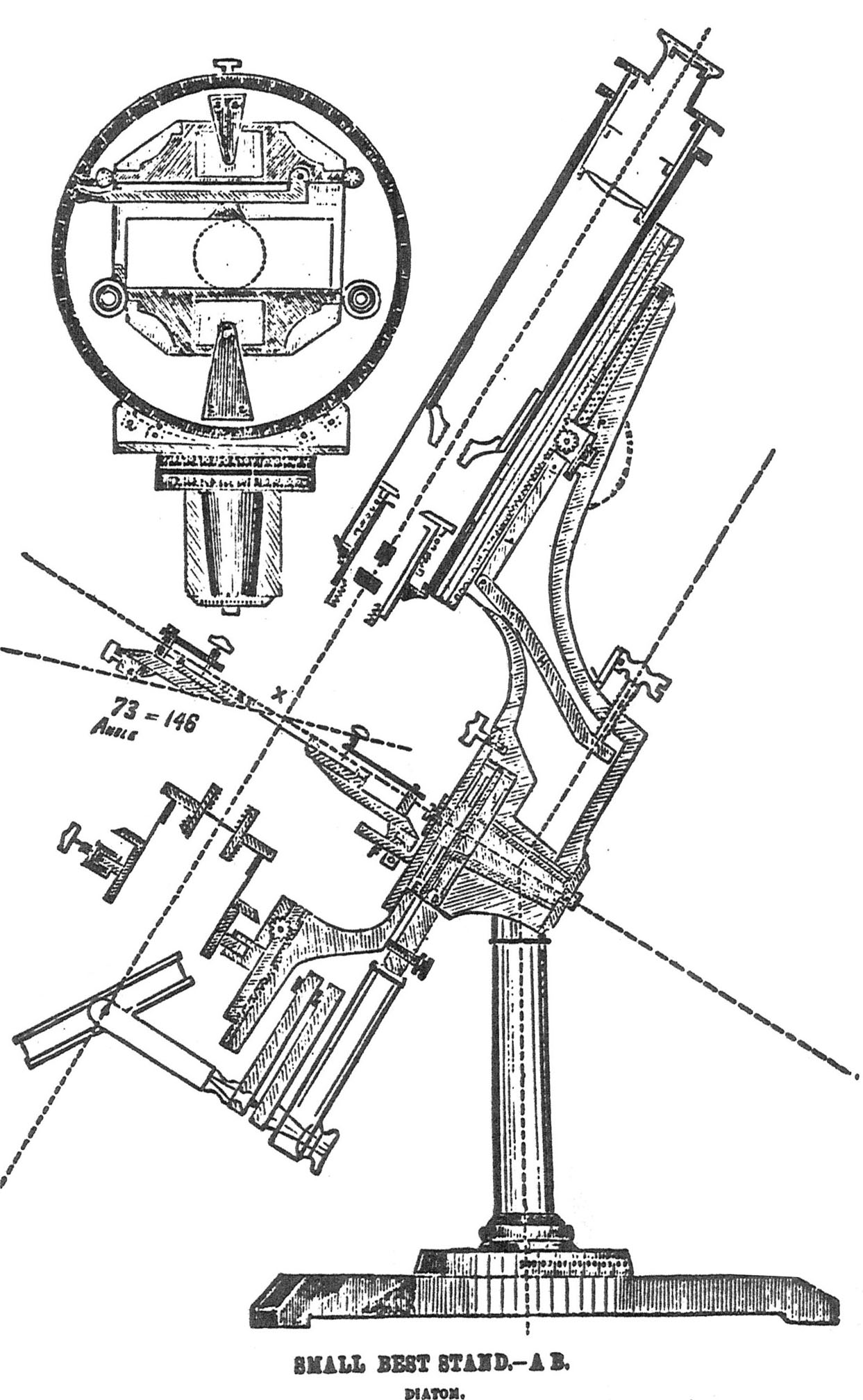 The second to largest
microscope that Bulloch produced, once he started
to make the A 1 stand, was shortly thereafter termed the 'Congress
Junior' model*, and it is likely the 'A B' stand pictured in the 1878
catalog is indeed that model, as it is described as 'similar to the
large stand but smaller.' It is also described in that catalog as the
'Diatom stand' which fits its description as the 'Congress Junior'*. A
cross-sectional view shows it to be quite similar to the A 1 stand,
except for a thinner stage with gliding slide support instead of
mechanical stage. Bulloch reports that this stage could be completely
turned upside down, slide underneath, to allow the greatest degree of
oblique lighting to be used. The original version of the Congress
Junior would also have the same tubular mirror support with double
articulating bars at the end.
The second to largest
microscope that Bulloch produced, once he started
to make the A 1 stand, was shortly thereafter termed the 'Congress
Junior' model*, and it is likely the 'A B' stand pictured in the 1878
catalog is indeed that model, as it is described as 'similar to the
large stand but smaller.' It is also described in that catalog as the
'Diatom stand' which fits its description as the 'Congress Junior'*. A
cross-sectional view shows it to be quite similar to the A 1 stand,
except for a thinner stage with gliding slide support instead of
mechanical stage. Bulloch reports that this stage could be completely
turned upside down, slide underneath, to allow the greatest degree of
oblique lighting to be used. The original version of the Congress
Junior would also have the same tubular mirror support with double
articulating bars at the end.
This was the precursor of the later, two-pillared version of
the
'Professional.' One unique feature of the diatom stage was
two separate hold down points, each acting on a
separate piece
of glass on opposite ends of the slide holder; I have not found a
surviving example of this exact stand, hence only the diagram is shown
here.
* As reported in the Proceedings of the Fourth annual meeting
of the American Society of Microscopists of 1881.
THE 'PROFESSIONAL'(c. 1879-1880's (first form) and 1880's- 1891(second
form).
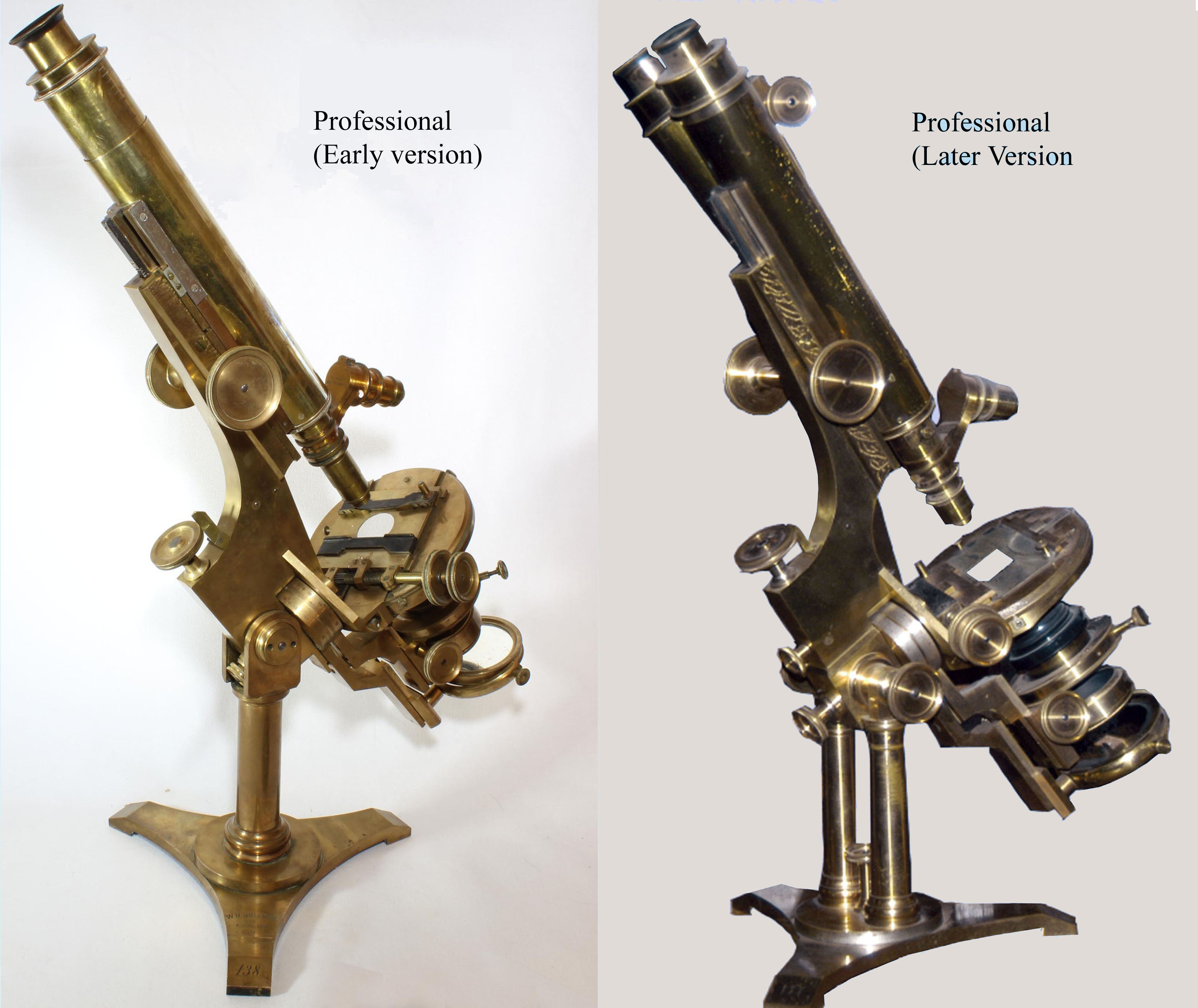
There is no mention of the 'Professional Model' in the 1878
catalog. The earliest reference to it I could find was in the Bulloch
Price list published in Frey in 1880, the list being dated to 1879. In
this description there is only one version of the
'Professional' described, and it is a single-pillar version. This
description fits the Professional Model seen on the web page of this
site nearly perfectly as seen
here.
A later, (much smaller) version of the single-pillar
Professional was
first advertised about 1889, and was also pictured in the 1890 catalog;
this smaller single-pillar version was called the 'Professional No 2'
(See the next entry). In the 1890 catalog the 'Professional
Model' had become a double pillar
microscope,
a smaller version of the Congress, essentially, a second version of the
'Congress Junior' or 'A B' previously mentioned. I would assume that
Bulloch realized that calling the A B the 'Junior' made it sound
trivial and therefore later called it the 'Professional,' as the large
single Pillar professional was phased out.
The
only differences between the early version of the 'Professional' and
the later 2-pillar version relate to the pillars and foot. There are,
of course two pillars on the later version, and although both could
rotate on the foot, only the 2-pillar later version had graduations for
this rotation, with the footplate slightly changed to accommodate these
engraved numbers. The stands are otherwise the same. Either could be
monocular or binocular, they had identical construction and could
accommodate different (but equal diameter) stages. For a detailed page
devoted to only the first version of the professional see here.
'PROFESSIONAL NUMBER 2'(c 1889-1891).
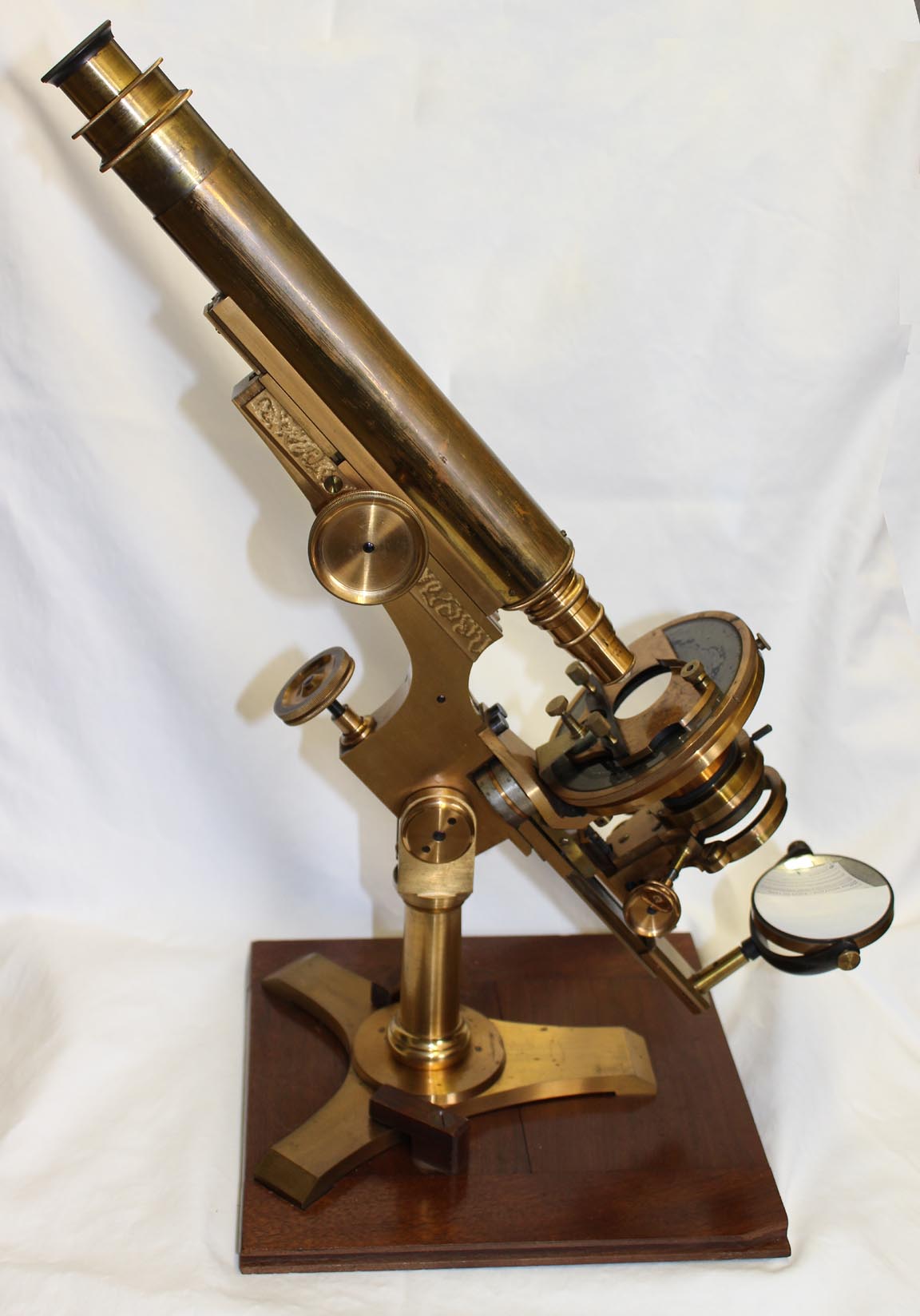
The 'Professional No. 2' was a much smaller and much lighter
stand
than either the single or double pillar 'Professional.' In fact, as is
seen in the illustration to the right, the 'Professional No.2 is
identical in every way to the 'Biological No 2' except for a slightly
longer tube length and its supporting part of the limb.
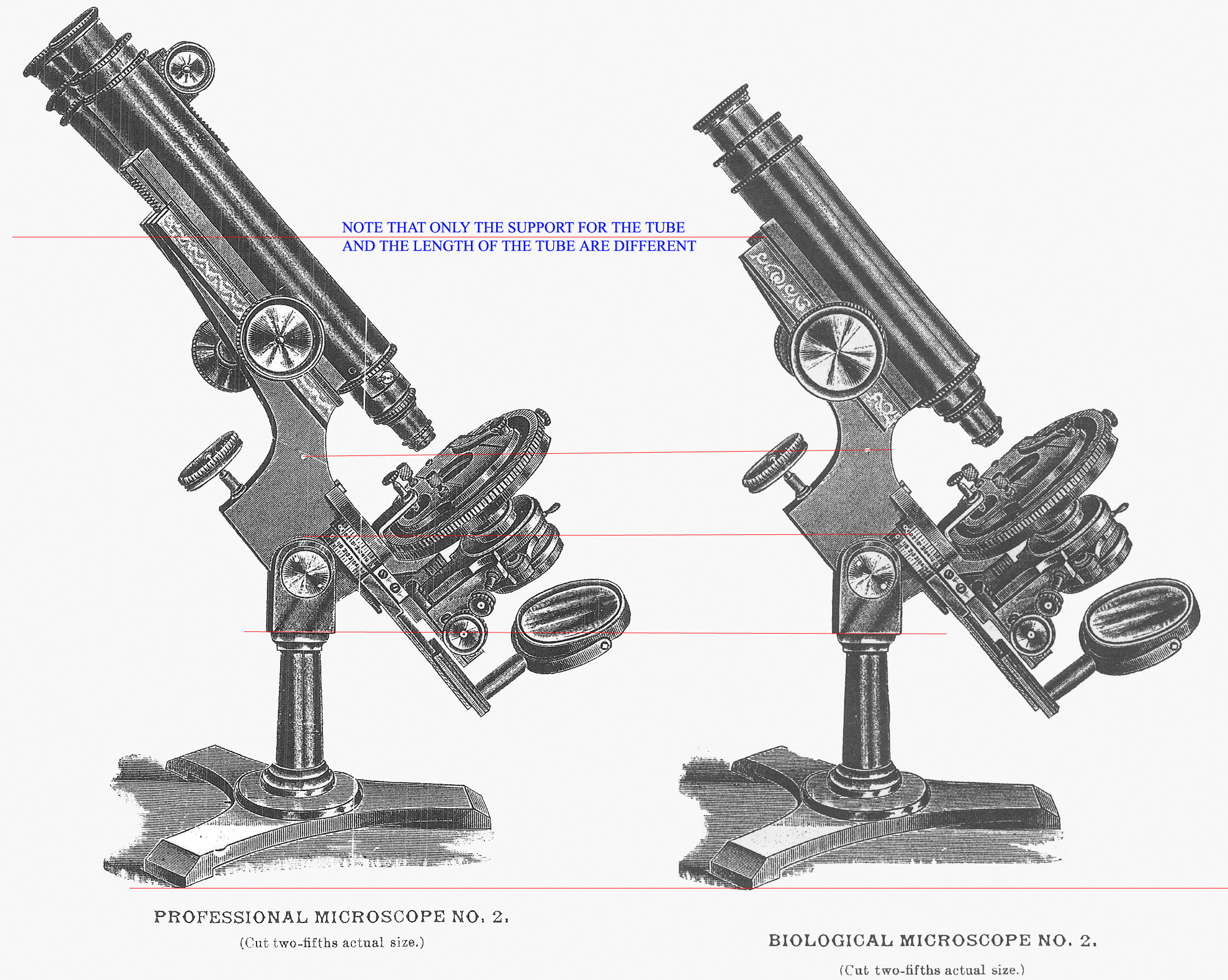 Although
some have suggested that all single-pillared 'Professional'
models should be called 'Professional No 2's, I strongly
disagree. After studying the literature, and the actual measurements of
these stands, it is clear that the early single-pillared stand was just
as big as the later 2-pillar version, and much larger than the later
'Professional No 2.' The early 'Professional' had identical size
components as the later 2-pillar model including overall height, stage
size, and thickness of the limb. The brace for the
saddle
fitting was also the same.
For additional images, with the Professional No. 2 next to its engravings, and also the much larger early version of the 'Professional' next to the 'Biological No 2 (a stand
almost identical to the Professional No 2), see here.
In addition, note the actual description of the Professional
from Frey, which refers to it as a 'Professional' and notes it is a
single-pillared instrument, and that it is '16 inches high when
arranged for use,' which is the exact same size as pictured in the
later 1890 catalog for the two pillar version, and far higher than the
13 inch high 'Professional No.2. Also note that the early
'Professional' has a much heavier arm with the triangular buttress
(brace) support coming down to the saddle fitting, not found on the 'Professional No. 2.'
Although
some have suggested that all single-pillared 'Professional'
models should be called 'Professional No 2's, I strongly
disagree. After studying the literature, and the actual measurements of
these stands, it is clear that the early single-pillared stand was just
as big as the later 2-pillar version, and much larger than the later
'Professional No 2.' The early 'Professional' had identical size
components as the later 2-pillar model including overall height, stage
size, and thickness of the limb. The brace for the
saddle
fitting was also the same.
For additional images, with the Professional No. 2 next to its engravings, and also the much larger early version of the 'Professional' next to the 'Biological No 2 (a stand
almost identical to the Professional No 2), see here.
In addition, note the actual description of the Professional
from Frey, which refers to it as a 'Professional' and notes it is a
single-pillared instrument, and that it is '16 inches high when
arranged for use,' which is the exact same size as pictured in the
later 1890 catalog for the two pillar version, and far higher than the
13 inch high 'Professional No.2. Also note that the early
'Professional' has a much heavier arm with the triangular buttress
(brace) support coming down to the saddle fitting, not found on the 'Professional No. 2.'
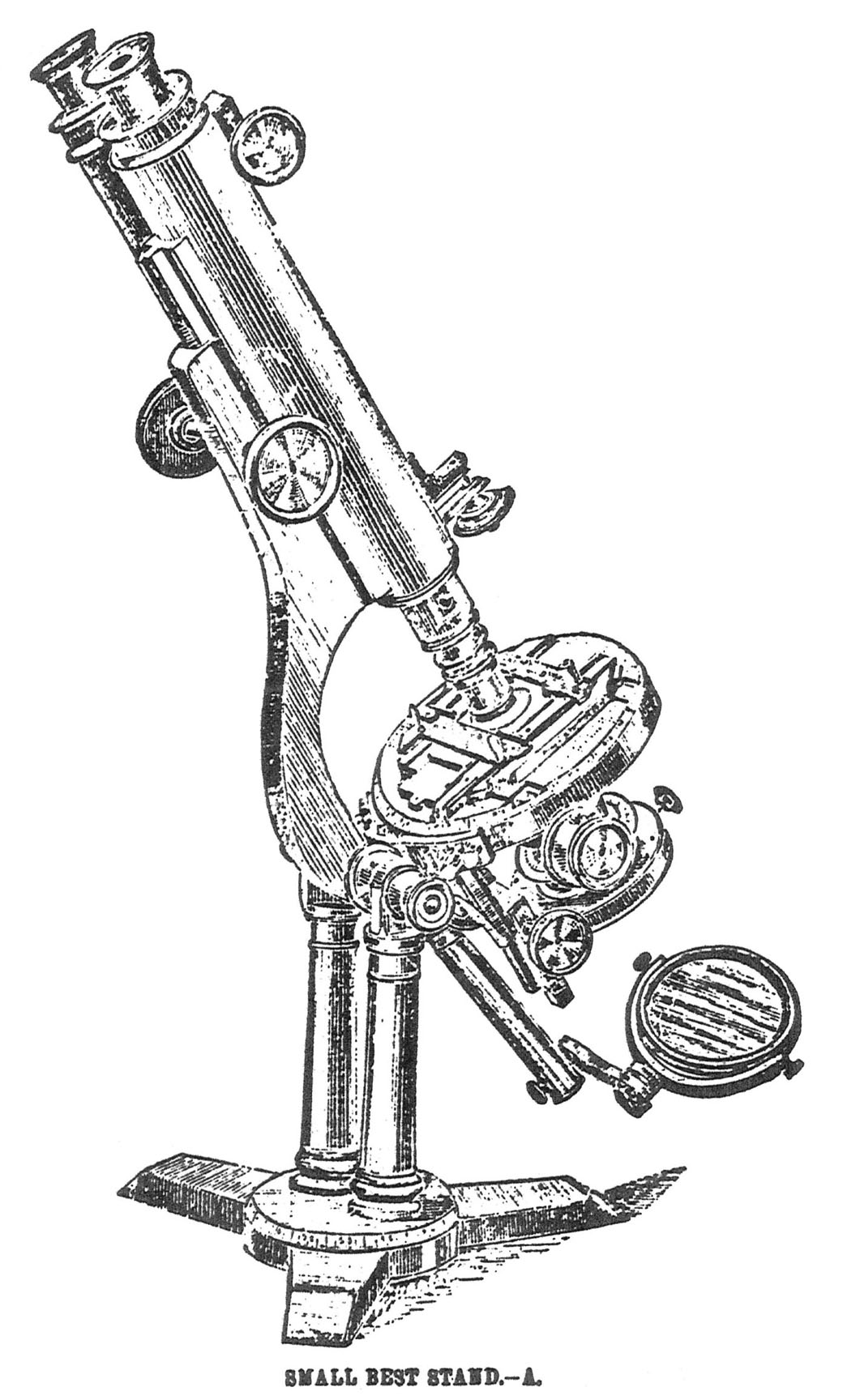 THE 'A' OR SMALL BEST STAND (c. 1870'S-1880'S)
THE 'A' OR SMALL BEST STAND (c. 1870'S-1880'S)
The 'A' Stand was Bulloch's third-class microscope at the
time of
his first catalog in 1878. He advertised it in journals published in
1879. I know of only one example surviving and it was in poor
condition and missing its substage. It had an old fashioned
nose piece type of fine-focus which would be quite inferior to his A1
and AB instruments.
THE 'B' STAND (c.1870'S-1880'S).
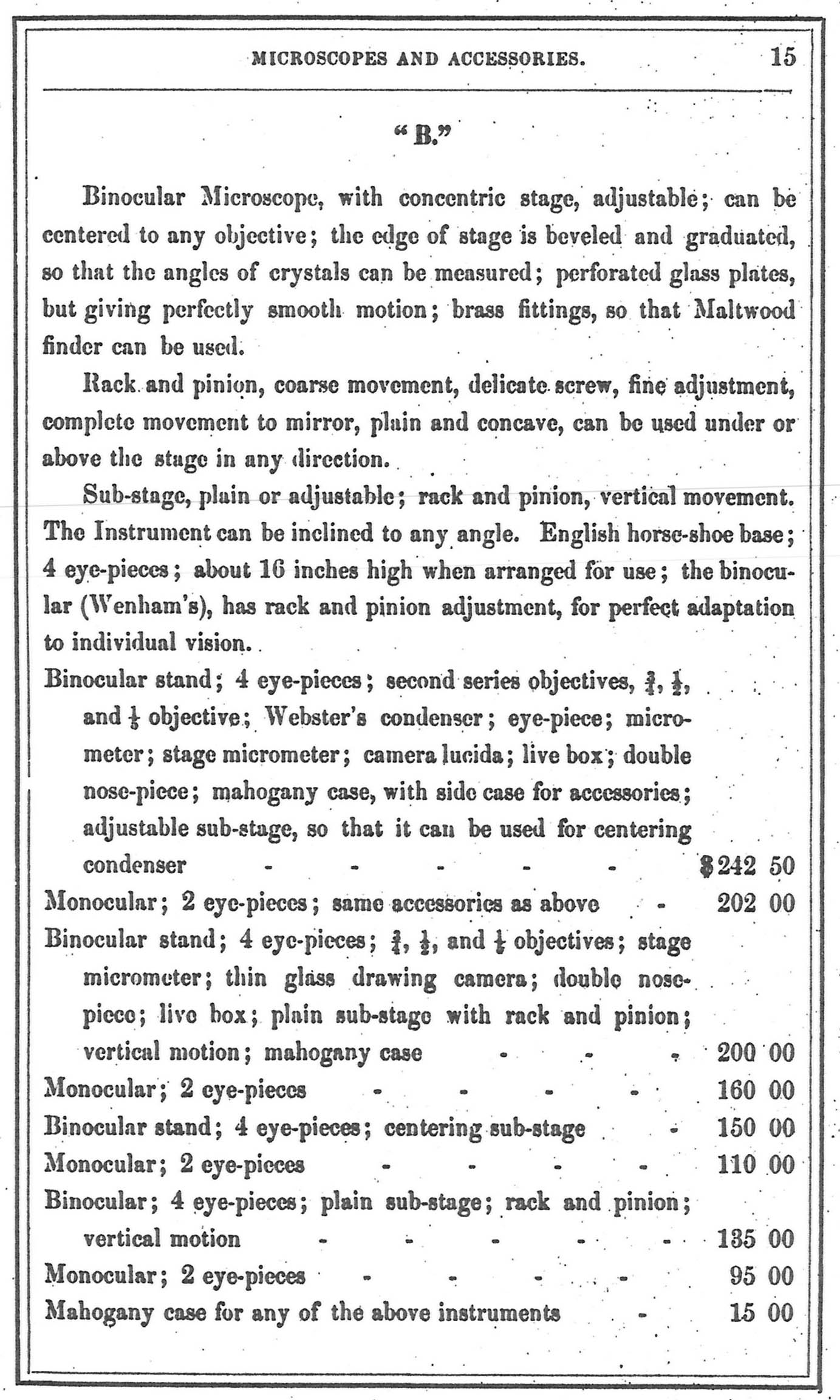 This
was the largest of Bulloch's stands with 'Crouch-type' or
'English-type' of curving foot. This foot was also seen on the 'D' and
'E' models. It had the rotating beveled glass stage. The substage
could be 'plain or adjustable.' We have no engravings of this scope and
no extant examples that I am aware of. In many ways it sounds like it
resembles stand 'D' though the exact differences are unclear.
This
was the largest of Bulloch's stands with 'Crouch-type' or
'English-type' of curving foot. This foot was also seen on the 'D' and
'E' models. It had the rotating beveled glass stage. The substage
could be 'plain or adjustable.' We have no engravings of this scope and
no extant examples that I am aware of. In many ways it sounds like it
resembles stand 'D' though the exact differences are unclear.
THE 'C' STAND (c. 1870's-1880's).
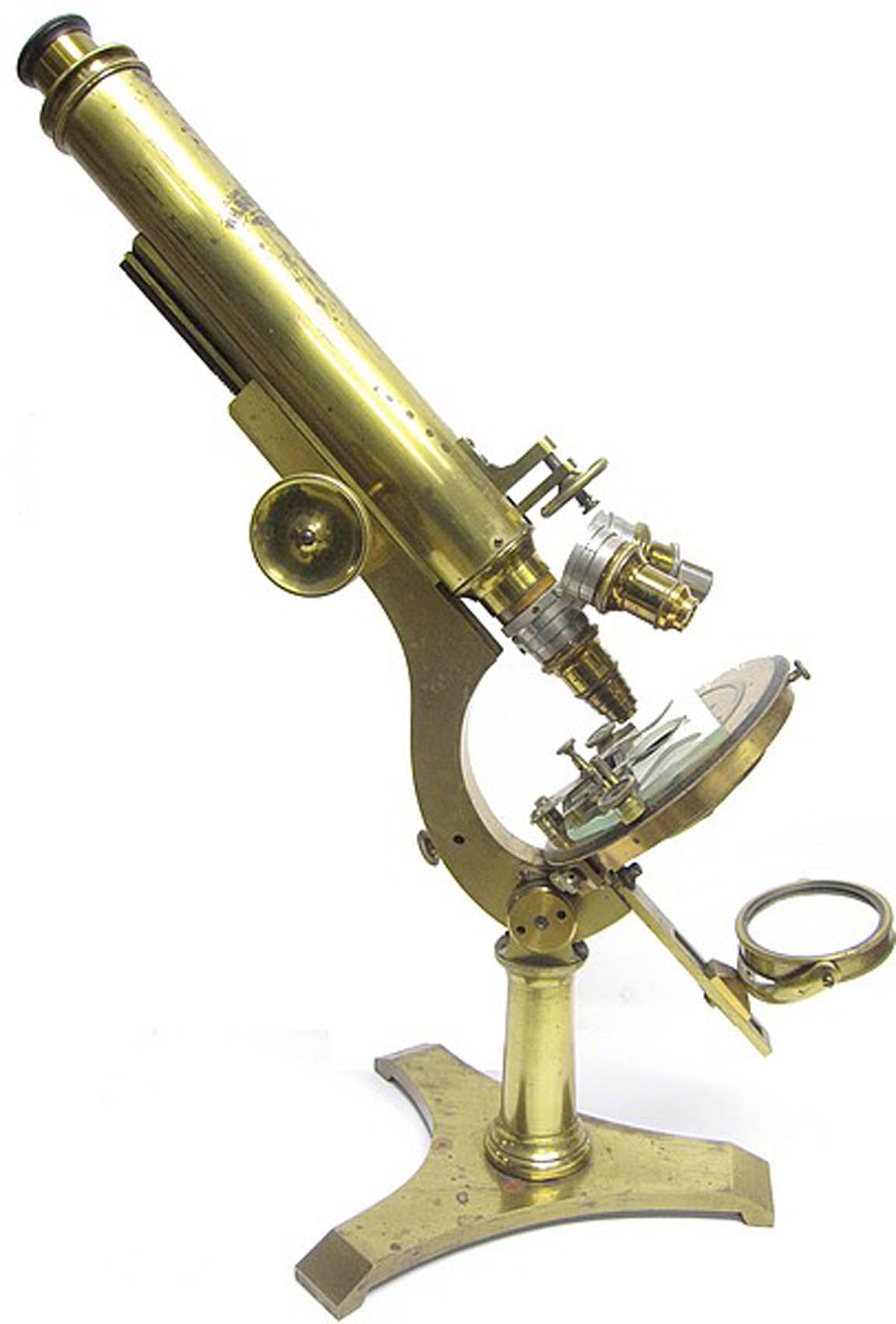
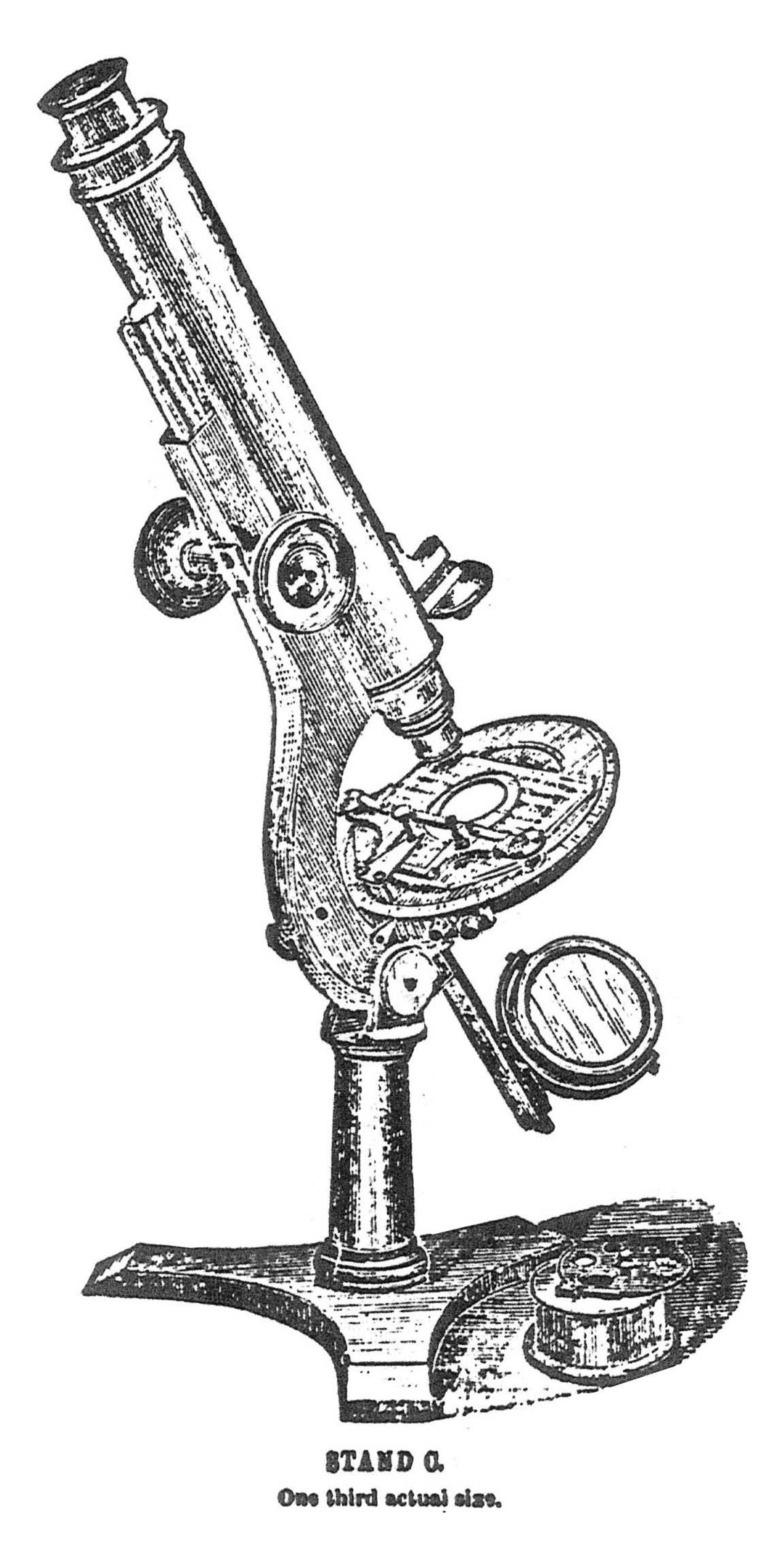 This stand is mounted on a flat equiaxed tripod with a short single pillar support and a glass stage with gliding slide holder. The substage support is a simple ring attached to the underside of the stage, but this ring was removable to allow oblique lighting. The author would like to thank Allan Wissner for allowing me to share images of this microscope, serial number 87 which was sold in 1876. I would like to point out to the reader the striking resemblance of the 'C' stand of Bulloch to the Zentmayer Army Hospital microscope; it is clear that Bulloch was emulating that stand in the 'C' and that Zentmayer clearly came up with the design first-see this image comparing the two. For more images of this example, see the link to Allan's Website.
This stand is mounted on a flat equiaxed tripod with a short single pillar support and a glass stage with gliding slide holder. The substage support is a simple ring attached to the underside of the stage, but this ring was removable to allow oblique lighting. The author would like to thank Allan Wissner for allowing me to share images of this microscope, serial number 87 which was sold in 1876. I would like to point out to the reader the striking resemblance of the 'C' stand of Bulloch to the Zentmayer Army Hospital microscope; it is clear that Bulloch was emulating that stand in the 'C' and that Zentmayer clearly came up with the design first-see this image comparing the two. For more images of this example, see the link to Allan's Website.
THE 'D' STAND (c.1870'S-1880'S)
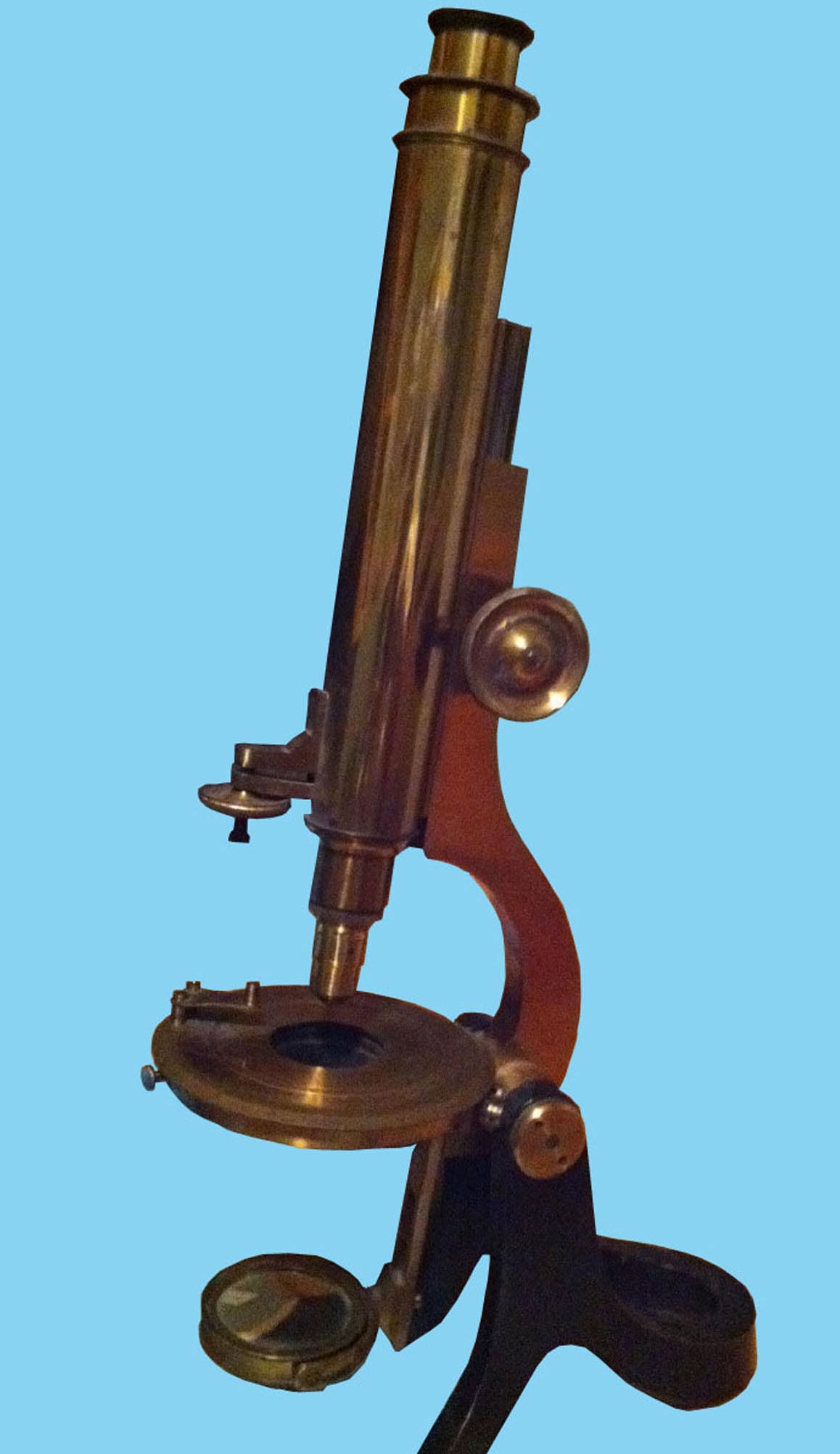 This stand is very similar
to the 'B' model. Because of a lack of
engravings and images of the 'B' stand, differences between the two are
unknown at this time. There must have been some major difference as the
cost between them was quite substantial. The substage support of the D
is a simple ring attached to the underside of the stage. Note the long
tube-length, nose piece fine focus, and 'English' foot.
This stand is very similar
to the 'B' model. Because of a lack of
engravings and images of the 'B' stand, differences between the two are
unknown at this time. There must have been some major difference as the
cost between them was quite substantial. The substage support of the D
is a simple ring attached to the underside of the stage. Note the long
tube-length, nose piece fine focus, and 'English' foot.
THE 'E' STAND (c. 1870's-1880's)
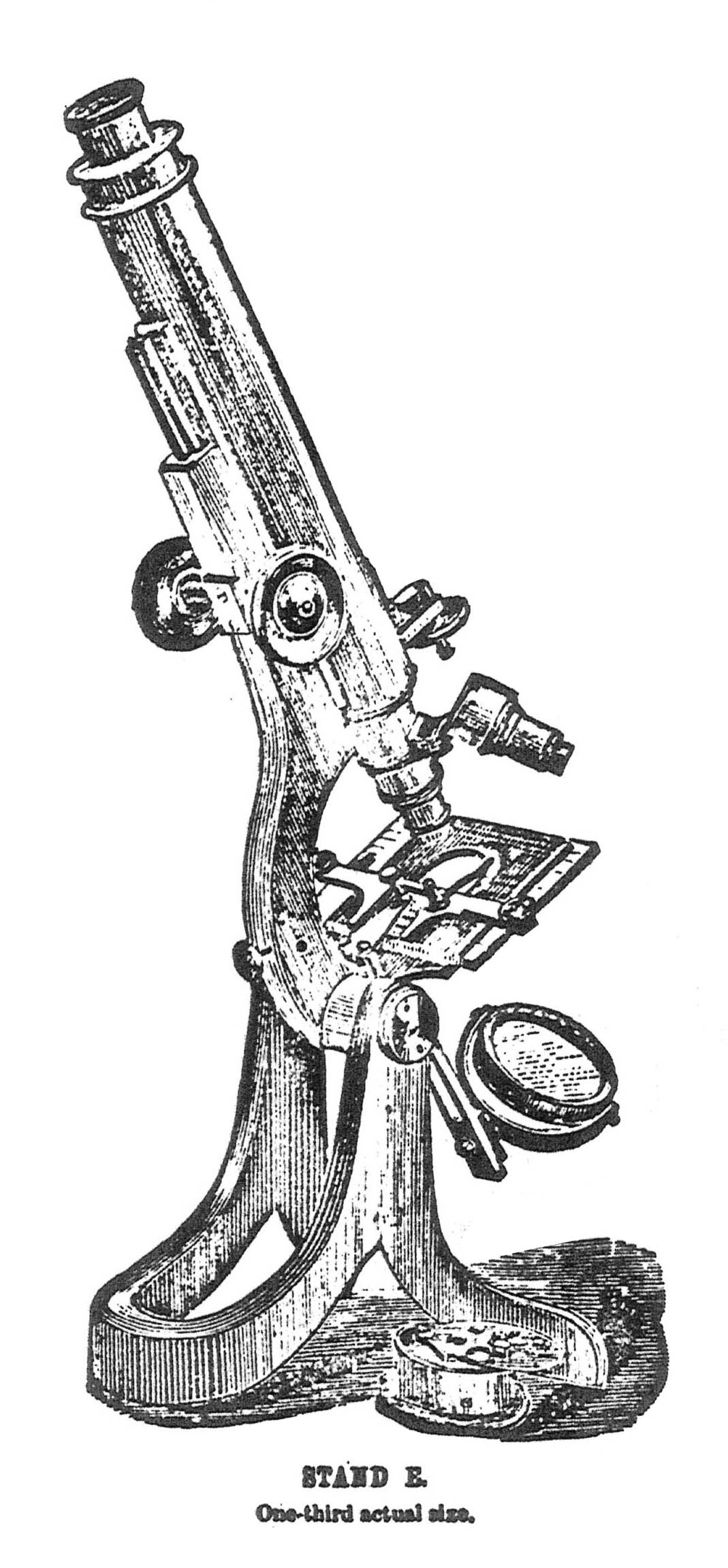 The 'E' is similar to the
D model except the stage is rectangular. It
is still glass-covered and with a gliding slide-holder. The substage
support is a simple ring attached to the underside of the stage. Again
there is a short nose piece fine focus and the foot is the 'Crouch' or
'English' type.
The 'E' is similar to the
D model except the stage is rectangular. It
is still glass-covered and with a gliding slide-holder. The substage
support is a simple ring attached to the underside of the stage. Again
there is a short nose piece fine focus and the foot is the 'Crouch' or
'English' type.
THE LITHOLOGICAL MICROSCOPES.(1880-1891)
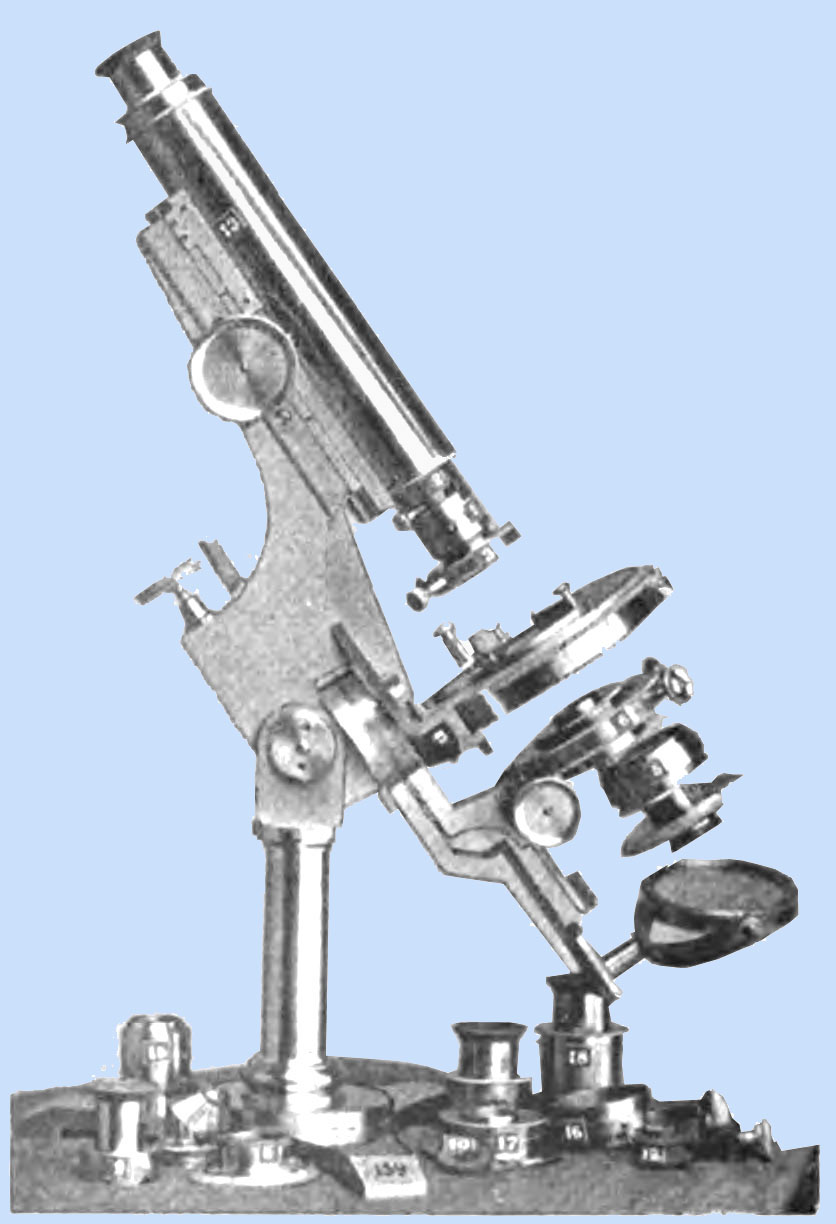
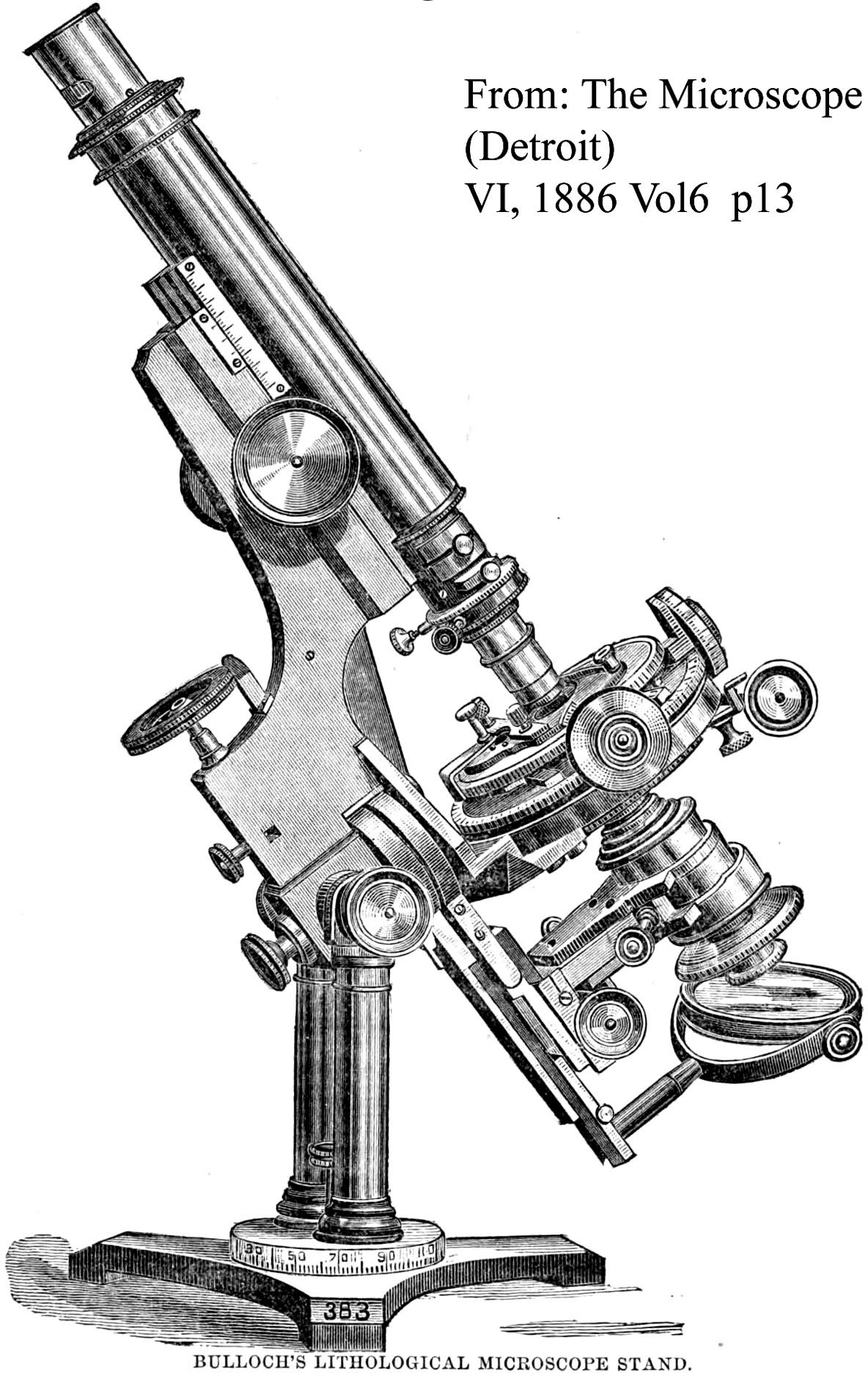 According
to an article published in the American Geologist, April
1889, p225, the first American Petrographic microscope was made by
Walter Bulloch in 1880 and had the serial number 139, and is pictured
to the left. As can be seen in the
photograph in that article, it was identical to the single-pillar Professional model as seen on this
website,
except for the nosepiece fittings and some of the substage apparatus.
The article goes on to describe the evolution of Bulloch's
'lithological'
microscopes through at least three changing designs. To my knowledge,
no example of any of them is in any public collection and I have never
seen one come up for sale. At least one is held in a private
collection. The 1890 catalog has two models, the 'Professional
Petrological Microscope' on twin pillars, as seen to the right, and the
'Standard Petrological Microscope,' for which there are no images
available. It would seem there were may have been three or more
different Bulloch petrographic
stands through the years. It seems likely that some other petrographic
stands still exist in private collections, but I have been unable to
locate any so far. Note the 'Professional Lithological (aka
'Professional Petrographical') microscope is built on the same plan.
According
to an article published in the American Geologist, April
1889, p225, the first American Petrographic microscope was made by
Walter Bulloch in 1880 and had the serial number 139, and is pictured
to the left. As can be seen in the
photograph in that article, it was identical to the single-pillar Professional model as seen on this
website,
except for the nosepiece fittings and some of the substage apparatus.
The article goes on to describe the evolution of Bulloch's
'lithological'
microscopes through at least three changing designs. To my knowledge,
no example of any of them is in any public collection and I have never
seen one come up for sale. At least one is held in a private
collection. The 1890 catalog has two models, the 'Professional
Petrological Microscope' on twin pillars, as seen to the right, and the
'Standard Petrological Microscope,' for which there are no images
available. It would seem there were may have been three or more
different Bulloch petrographic
stands through the years. It seems likely that some other petrographic
stands still exist in private collections, but I have been unable to
locate any so far. Note the 'Professional Lithological (aka
'Professional Petrographical') microscope is built on the same plan.
THE 'NEW BIOLOGICAL', LATER CALLED THE 'BIOLOGICAL NO 1' and after Bulloch died, simply the 'BIOLOGICAL' by Meyrowitz
(c. 1879/80-1890)
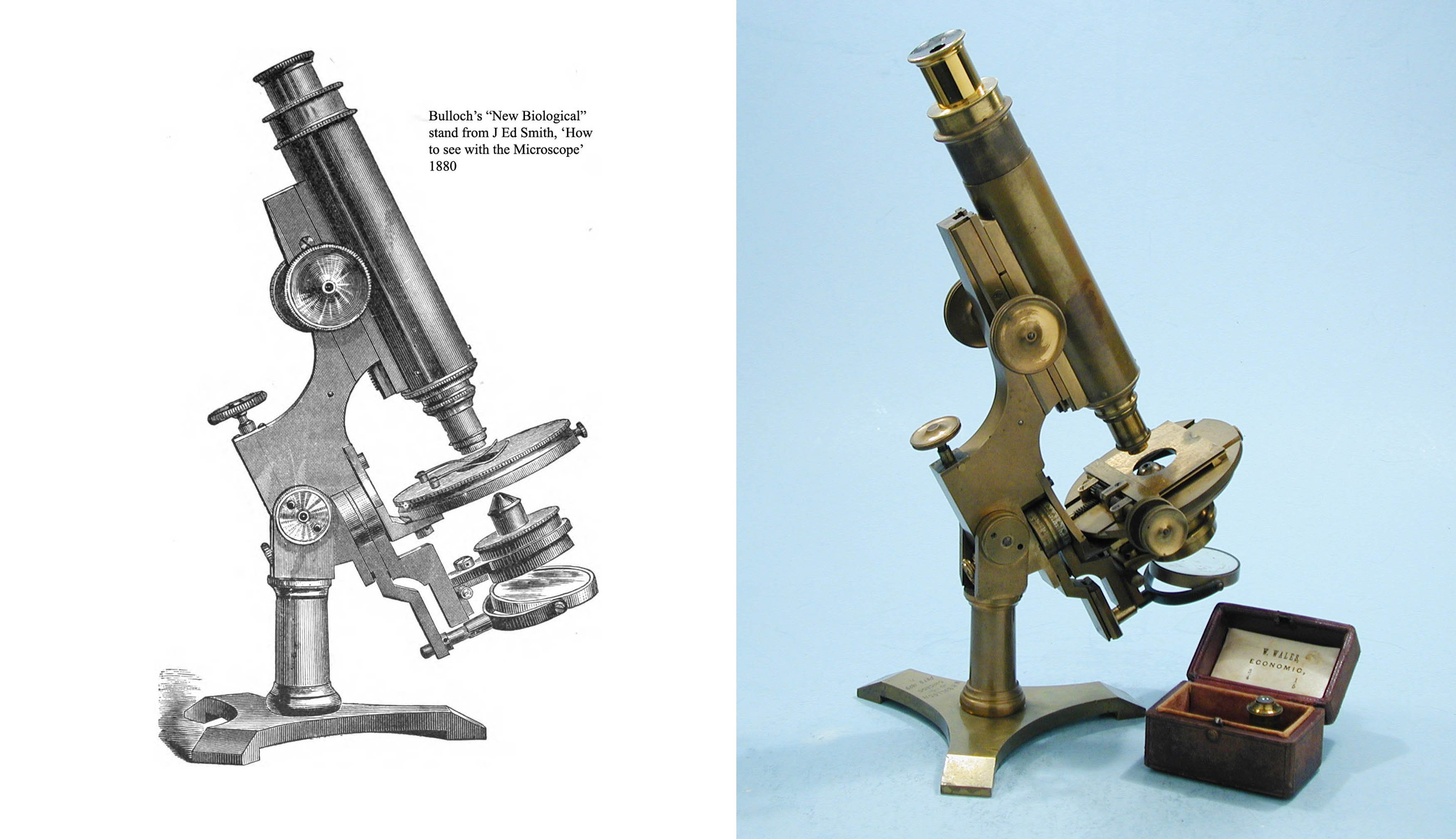 This
model, as reported in the 1880 Journal of the RMS, was 'a more recent model than the Congress' and 'Patented 1879.' Since the
Congress was
reportedly made starting in 1877, it follows that the first Biologicals
were made sometime thereafter, probably starting 1879, but no later
than 1880. The lowest serial number for the Biological that I have a
record for is number 121. Noting that 139 is known to be from
1880, and
also noting the patent date of 1879 is engraved on number 121, a
starting date of about 1879 is consistent with this. The Biological's
features included a short single pillar on a flat tripod foot, dual
swinging tailpieces, a saddle fitting to support the stage (not seen in
any model in the 1878 catalog, and not seen in the 1879 patent either),
and long-lever fine focus. The tube length was five inches, but with
draw tube could extend it to ten. The tailpieces on the biological were
usually zig-zag or S-shaped. Although the substage was on a separate
tailpiece from the mirror, its adjustment was by manually pushing it up
or down; rack and pinion adjustment of the substage was one of the later
Biological No.
2's improvements.
This
model, as reported in the 1880 Journal of the RMS, was 'a more recent model than the Congress' and 'Patented 1879.' Since the
Congress was
reportedly made starting in 1877, it follows that the first Biologicals
were made sometime thereafter, probably starting 1879, but no later
than 1880. The lowest serial number for the Biological that I have a
record for is number 121. Noting that 139 is known to be from
1880, and
also noting the patent date of 1879 is engraved on number 121, a
starting date of about 1879 is consistent with this. The Biological's
features included a short single pillar on a flat tripod foot, dual
swinging tailpieces, a saddle fitting to support the stage (not seen in
any model in the 1878 catalog, and not seen in the 1879 patent either),
and long-lever fine focus. The tube length was five inches, but with
draw tube could extend it to ten. The tailpieces on the biological were
usually zig-zag or S-shaped. Although the substage was on a separate
tailpiece from the mirror, its adjustment was by manually pushing it up
or down; rack and pinion adjustment of the substage was one of the later
Biological No.
2's improvements.
THE BIOLOGICAL No 2.
(later, when modified by Meyrowitz, called the 'NEW BULLOCH BACTERIOLOGICAL')
(c. 1880-1890's)
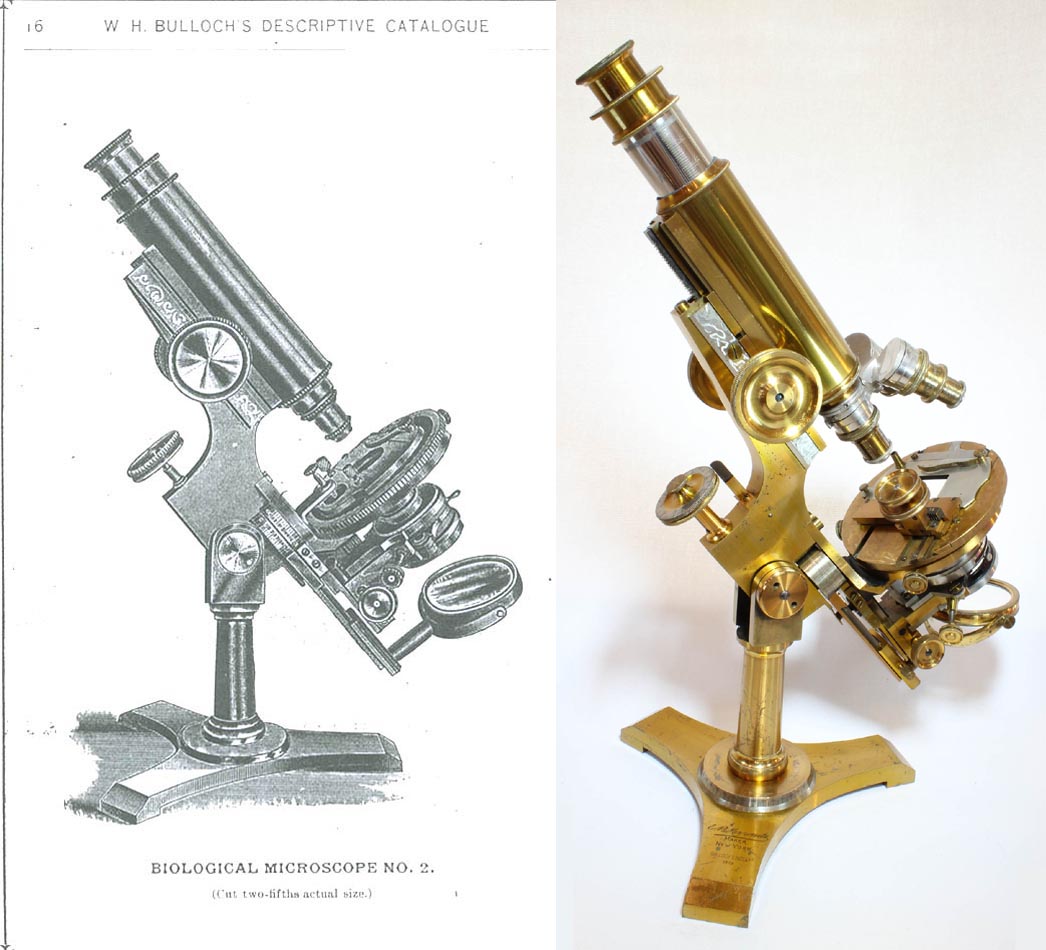 The Biological No 2 was a more complex stand than the Biological No 1. This is unlike the Professional and Histological stands, where the No 2 was less complex. This later stand featured the straight tailpieces. The example seen here, renamed the 'BULLOCH BACTERIOLOGICAL' was one sold by and modified by Meyrowitz, and
has diagonal rack and pinion focusing, for instance. See the Bulloch Bacteriological pages
for more details about this example. Meyrowitz renamed this modified Biological No. 2, the 'New Bulloch Bacteriological' and it was still offered for sale in the 1894 Meyrowitz Catalog as such, noting that Bulloch had died in 1891.
The Biological No 2 was a more complex stand than the Biological No 1. This is unlike the Professional and Histological stands, where the No 2 was less complex. This later stand featured the straight tailpieces. The example seen here, renamed the 'BULLOCH BACTERIOLOGICAL' was one sold by and modified by Meyrowitz, and
has diagonal rack and pinion focusing, for instance. See the Bulloch Bacteriological pages
for more details about this example. Meyrowitz renamed this modified Biological No. 2, the 'New Bulloch Bacteriological' and it was still offered for sale in the 1894 Meyrowitz Catalog as such, noting that Bulloch had died in 1891.
THE HISTOLOGICAL, (1880'S-1891)
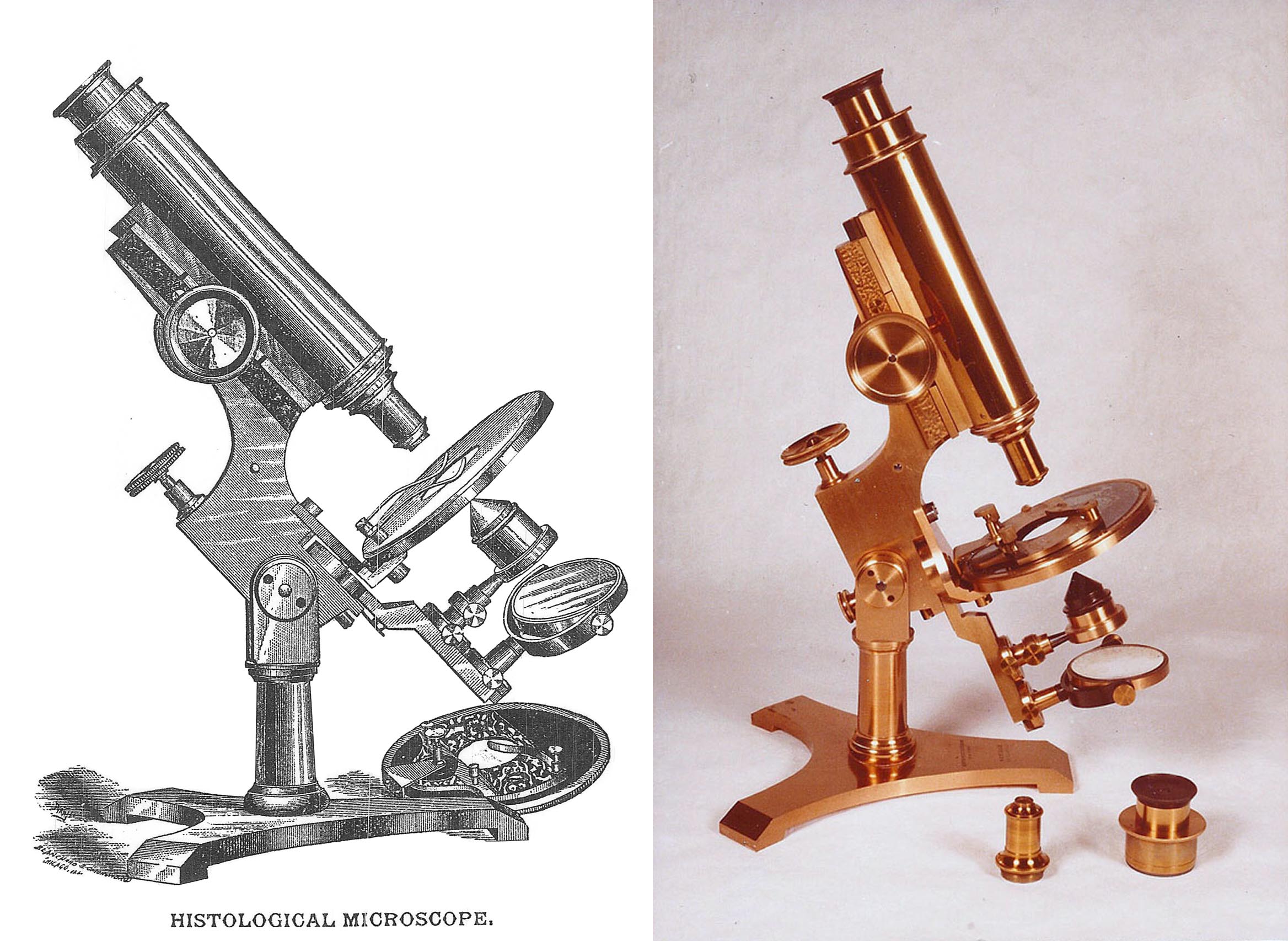 The
Histological was one of the simplest of Bulloch's microscopes to use a saddle fitting for the stage to isolate it from the movement of the single swinging substage. It was also the cheapest to have a condenser
fitting on the tailpiece. Like the Histological No 2, coarse focus by rack and
pinion, fine by long lever screw. A major difference between the two
was the ability to rotate the stage and change stages on the
Histological model. In addition,
this model had a condenser support which was designed to accept an
objective as a condenser, and had a cone diaphragm. A setscrew allowed
this condenser fitting to be centered. The mirror was planoconcave, and
could move up and down its supporting tailpiece, as well as rotate
above the stage for illuminating opaque objects. This histological model was not shown in the 1878 Bulloch catalog.
The
Histological was one of the simplest of Bulloch's microscopes to use a saddle fitting for the stage to isolate it from the movement of the single swinging substage. It was also the cheapest to have a condenser
fitting on the tailpiece. Like the Histological No 2, coarse focus by rack and
pinion, fine by long lever screw. A major difference between the two
was the ability to rotate the stage and change stages on the
Histological model. In addition,
this model had a condenser support which was designed to accept an
objective as a condenser, and had a cone diaphragm. A setscrew allowed
this condenser fitting to be centered. The mirror was planoconcave, and
could move up and down its supporting tailpiece, as well as rotate
above the stage for illuminating opaque objects. This histological model was not shown in the 1878 Bulloch catalog.
A Histological Bulloch microscope was mentioned in the American J of Microscopy and Pop Science Vol IV 1879, p99, but this is likely a typographical error as I can find no engraving from that year, and I found several other historical errors where the word 'histological' and 'biological' were used interchangably to refer to Bulloch microscopes. An example of this error is in Watson's report of their microscope 'based on Bulloch's Histological' but the engraving clearly shows it is based on the Biological.
THE HISTOLOGICAL NO 2. (1880'S-1891)
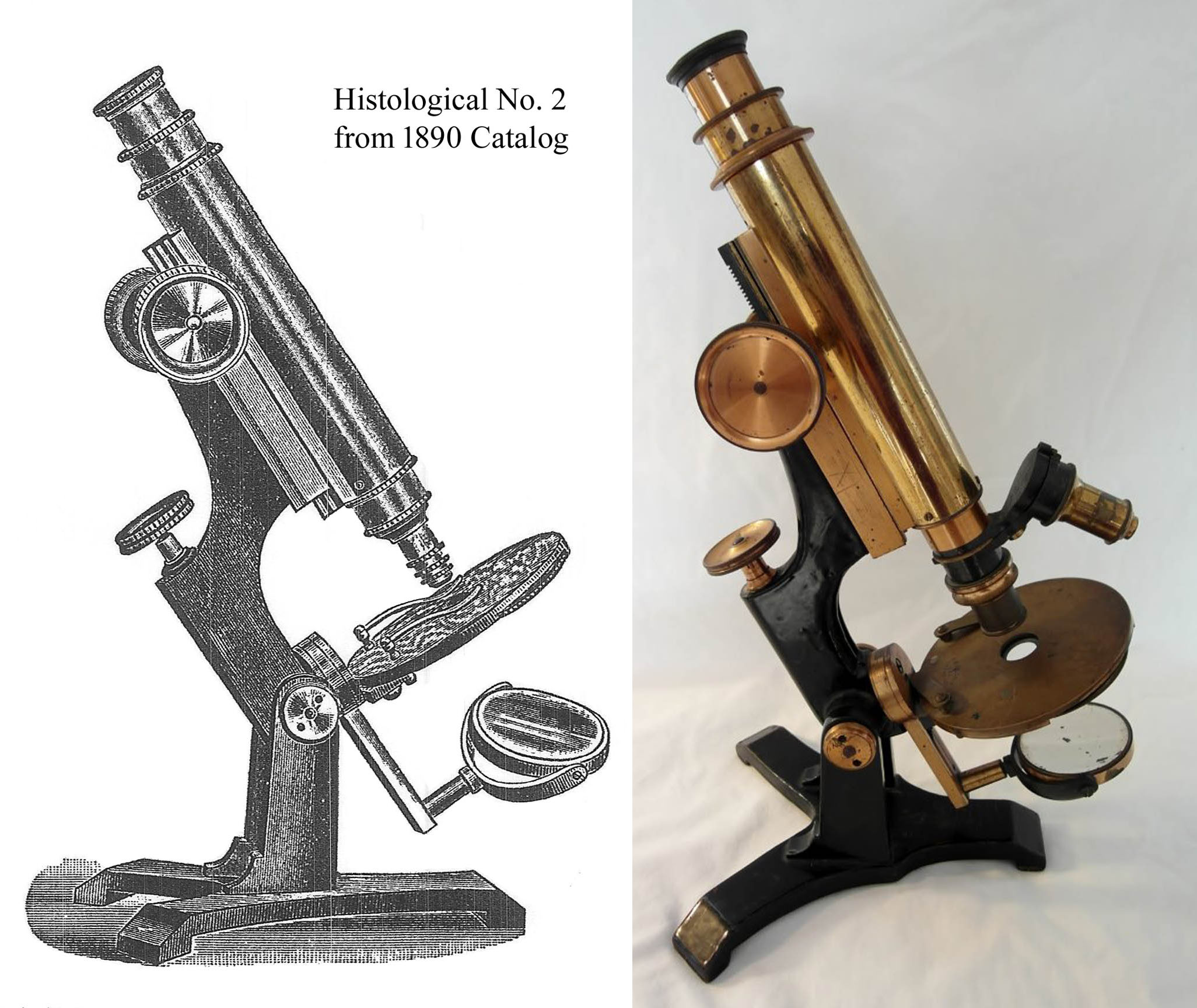 In contrast to the Biological No 2, the Histological No 2, was simpler
than the Histological Model.
The limb, foot, and upright supports were of painted iron with the optical parts and stage of polished brass. Coarse focus by rack and
pinion, fine by long lever screw. The plain stage had a wheel of
apertures on its underside. The mirror was planoconcave, and could move
up and down its supporting tailpiece, as well as rotate above the stage
for illuminating opaque objects. The stage was fixed, and not
isolated by a saddle fitting.
In contrast to the Biological No 2, the Histological No 2, was simpler
than the Histological Model.
The limb, foot, and upright supports were of painted iron with the optical parts and stage of polished brass. Coarse focus by rack and
pinion, fine by long lever screw. The plain stage had a wheel of
apertures on its underside. The mirror was planoconcave, and could move
up and down its supporting tailpiece, as well as rotate above the stage
for illuminating opaque objects. The stage was fixed, and not
isolated by a saddle fitting.
The author is grateful to Mr. Mark Stedman for providing images of this microscope.
THE 'F' OR 'STUDENT' STAND (c. 1870's-1880's)
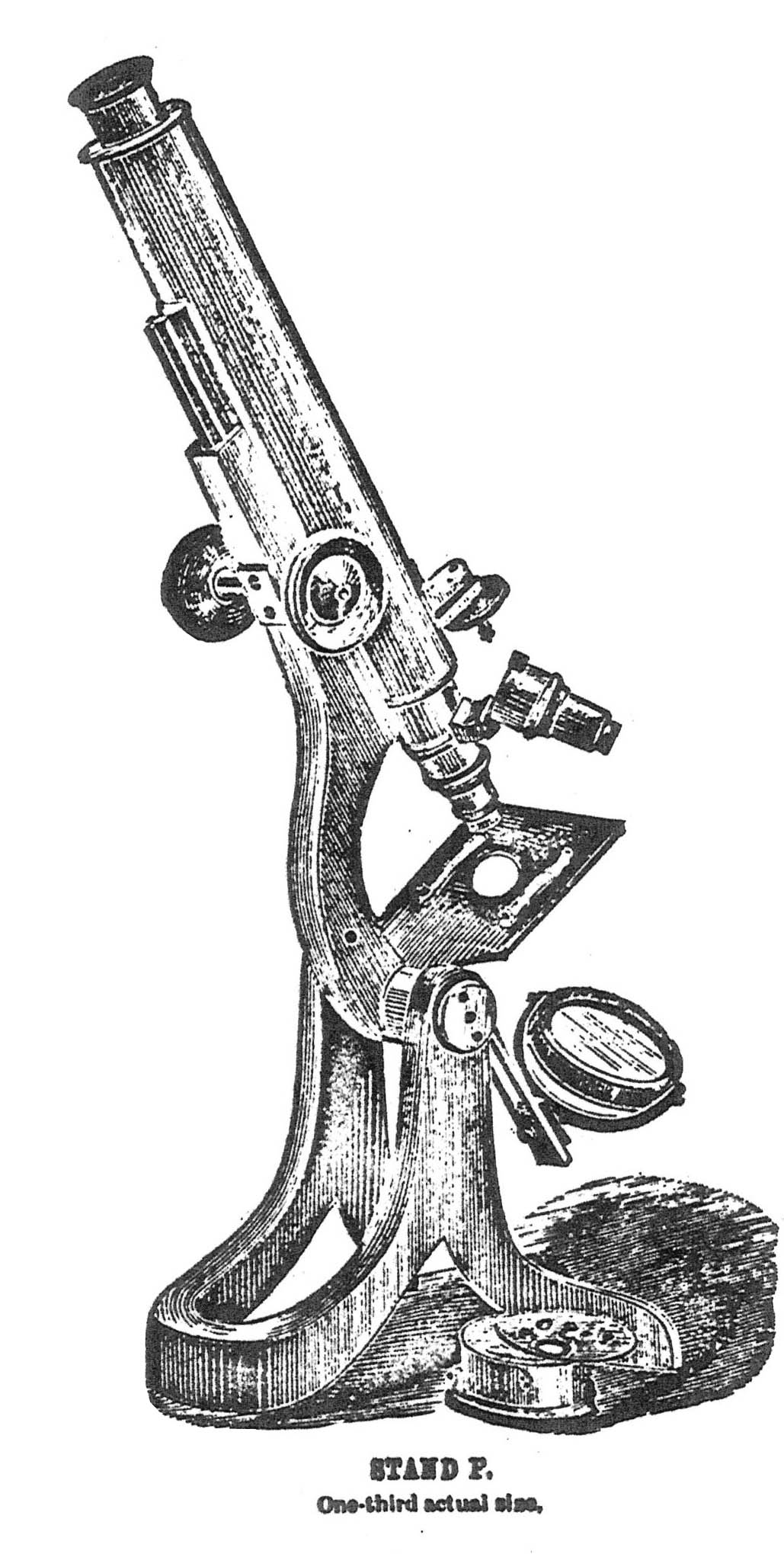 Bulloch produced at
least three different student stands and this one,
the 'F model is the earliest we have records of. This microscope is
similar to the E stand except the stage is plane with stage clips.
Again the nosepiece is fitted for fine focus and the foot is the
'Crouch' or 'English' type.
The substage support is a simple ring attached to the underside of the
stage. I know of no extant examples.
Bulloch produced at
least three different student stands and this one,
the 'F model is the earliest we have records of. This microscope is
similar to the E stand except the stage is plane with stage clips.
Again the nosepiece is fitted for fine focus and the foot is the
'Crouch' or 'English' type.
The substage support is a simple ring attached to the underside of the
stage. I know of no extant examples.
THE 'NEW STUDENT' MODEL (c. 1885)
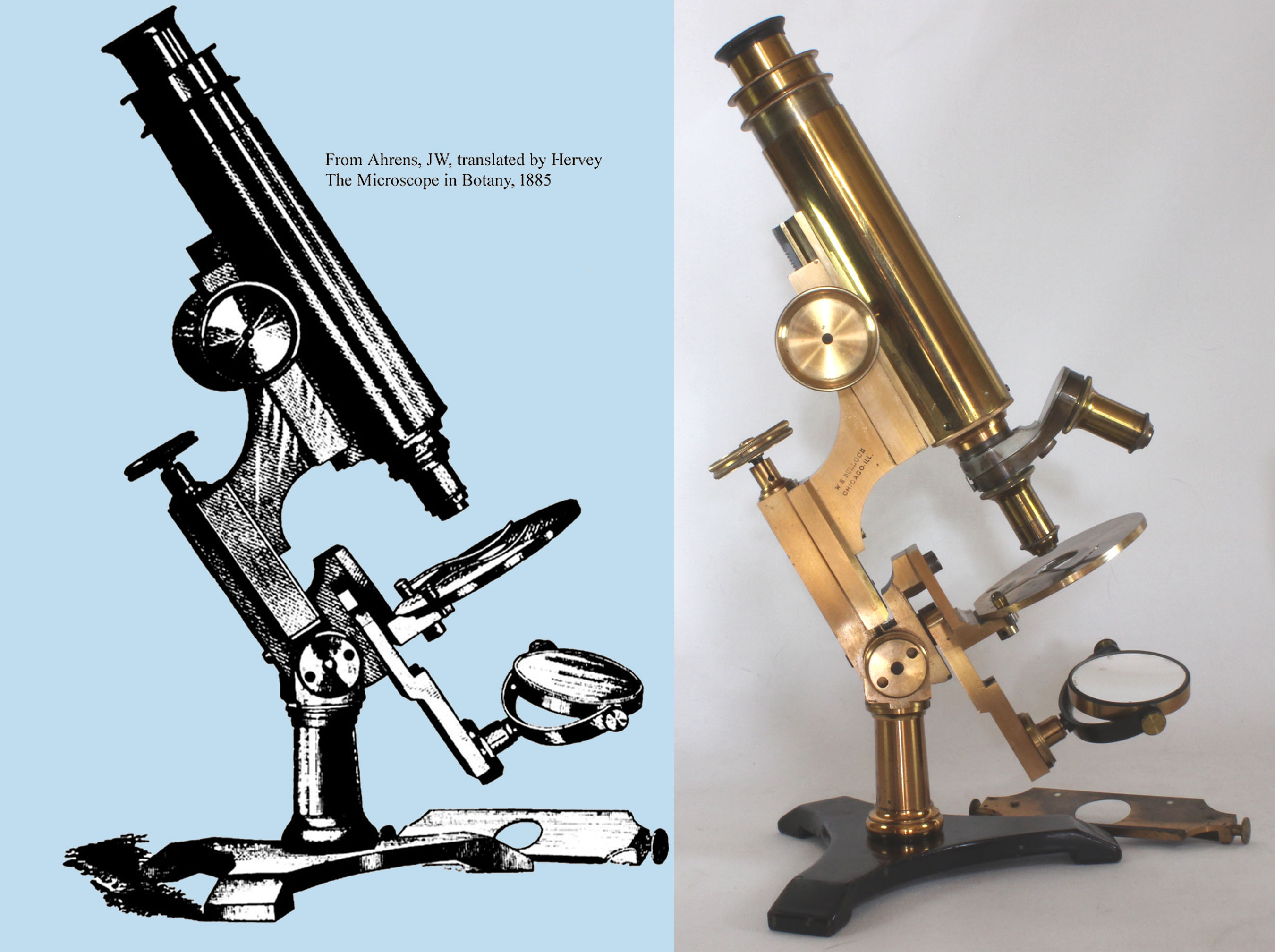 This
instrument, apparently the second of three or four known 'student'
designs, is not listed in the 1878 catalog, the 1890 catalog or the
1879 list from Frey. The only engravings of it appear in the English
translation of 'The Microscope in Botany' by Behrens, published in
1885, and in an advertisement in 'The Microscope, an Illustrated
Monthly Journal' from
the same year. By the 1890 catalog, the Student microscope was a much
simpler and cheaper model (see final form below). This microscope
arises on a very short
single pillar with small uprights at its top, much like the Biological
models, but much shorter. A black-painted flat tripod supports the
pillar. It has a
round but fixed stage, which can accept clips, or as an option the
gliding stage slide-carrier as shown here.
This
instrument, apparently the second of three or four known 'student'
designs, is not listed in the 1878 catalog, the 1890 catalog or the
1879 list from Frey. The only engravings of it appear in the English
translation of 'The Microscope in Botany' by Behrens, published in
1885, and in an advertisement in 'The Microscope, an Illustrated
Monthly Journal' from
the same year. By the 1890 catalog, the Student microscope was a much
simpler and cheaper model (see final form below). This microscope
arises on a very short
single pillar with small uprights at its top, much like the Biological
models, but much shorter. A black-painted flat tripod supports the
pillar. It has a
round but fixed stage, which can accept clips, or as an option the
gliding stage slide-carrier as shown here.
There is a shallow dovetail slot machined into the underside
of the
stage to accept substage apparatus, which would have slid in from the
front to back. The stage is supported by a saddle, isolating it from
the movement of the swinging tailpiece, making it the cheapest of the
microscopes so equipped. This saddle fitting screws to a part of brass
of the fine focus casing. The microscope differs from the Histological
model in that there is no provision for a condenser fitting on the
tailpiece.
Coarse focus is by straight rack and pinion, fine
focus by very fine threaded screw acting on the stem. The main optical
tube is five inches long, excluding nosepiece and ocular. There is a
long draw tube, equal in length to the main tube.
The
microscope is notable for the lack of a serial number anywhere on the
instrument and also for the location of the signatures of 'W. H.
Bulloch, Chicago, Ill.' on the right side of the arm, and 'Meyrowitz
Brothers, New York' on the left side of the arm.
This is a very well-made microscope. The example shown here
is the only example of this exact model that I have seen.
'STUDENT' MODEL (Third Form, after 1885-c. 1889)
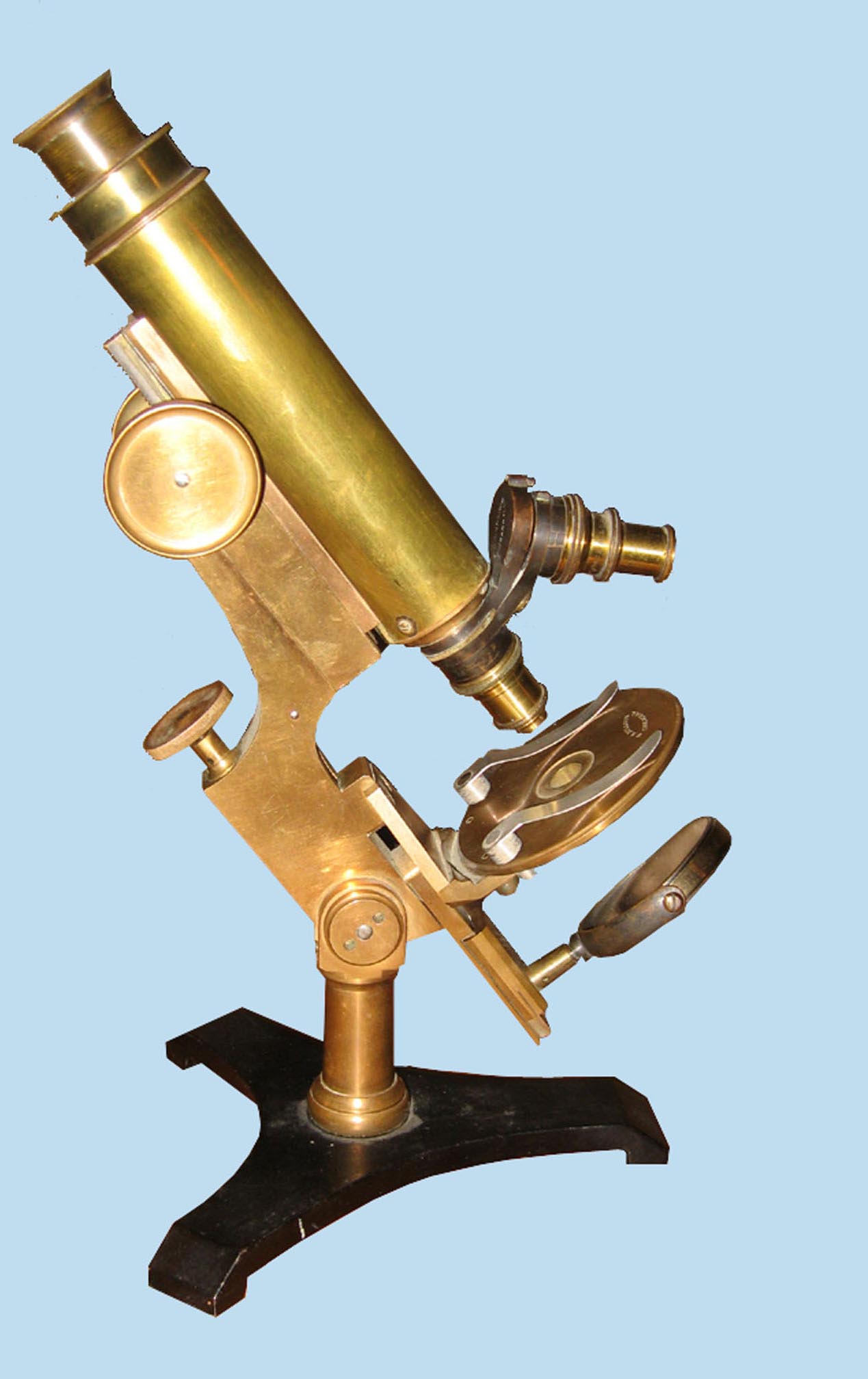
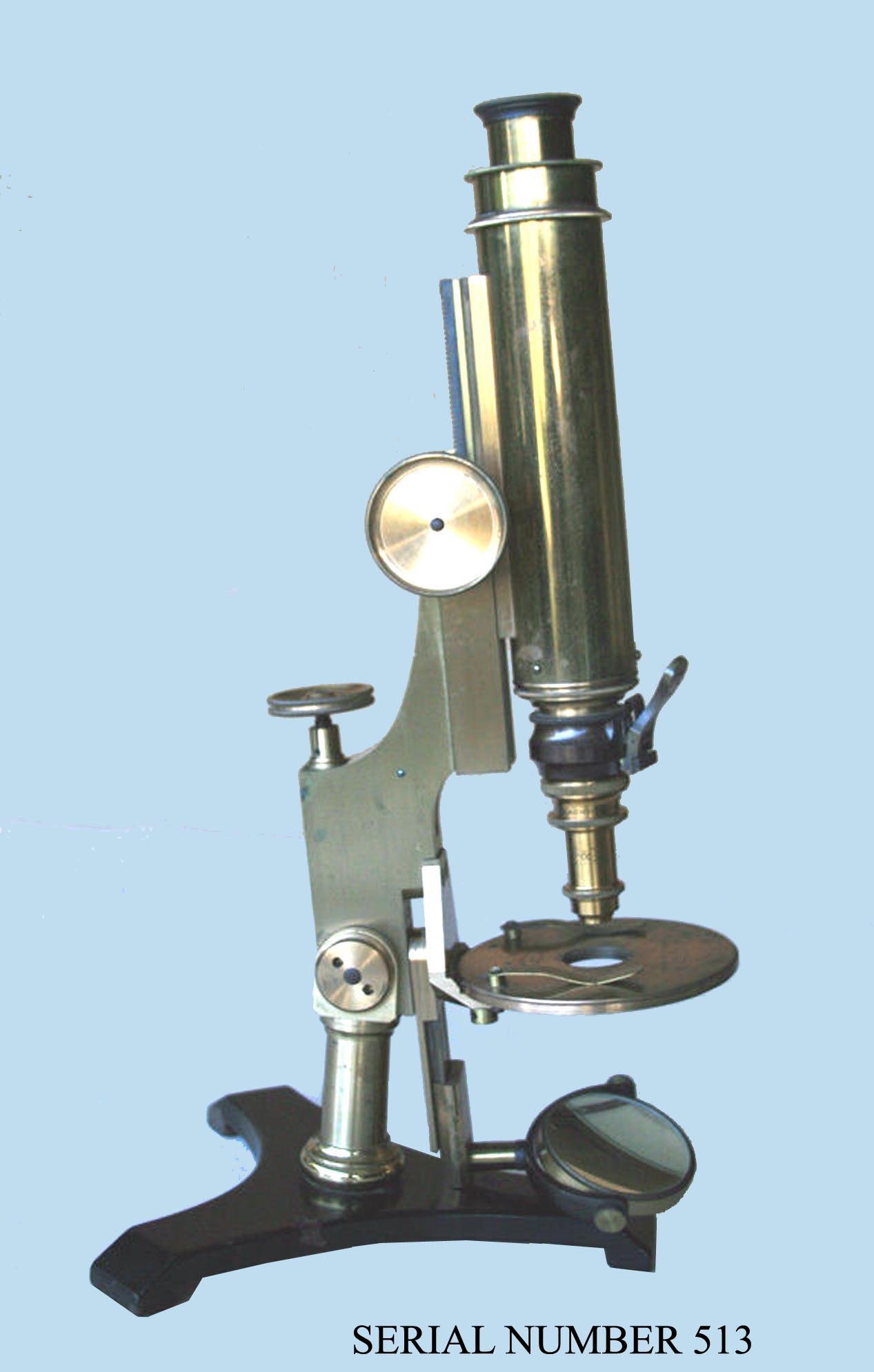 This
instrument, apparently the third of four known 'student' designs,
is not listed in the 1878 catalog, the 1890 catalog or the 1879 list
from Frey. By the 1890 catalog, the Student microscope was a much
simpler and cheaper model (see below). You will note the limb on the
example shown here is slightly different from the 'New Student' model
noted just above this entry, being thicker, but not as heavy as any of
the other models to use a saddle fitting. The stand also features the
newer straight
tailpiece instead of the zig-zag shape found in the 'New Student'
above. Like the 'New Student it has no provision for a condenser on the
tailpiece. It has a round but fixed stage with clips (these clips are a
modern replacement in the top example, original in the bottom example)
and a cylinder is affixed to the underside to
accept substage apparatus. The stage is supported by a saddle,
isolating it from the movement of the swinging tailpiece. Because this
model has a long lever fine focus, the attachment of the saddle is much
simpler than the microscope shown just above this one. The
mirror can be adjusted up or down on its tailpiece. The microscope
differs from the Histological model in that there is no provision for a
condenser fitting on the tailpiece, the tailpiece is rectangular rather
than having a ring shape at its top, and the saddle fitting is anchored
to a protruding piece of brass from the limb, which makes the entire
limb thinner than the Histological model. An example of this microscope
was offered for sale on E bay and the seller has kindly granted me
permission to show his photographs of the stand here on my website.
A second example was sold on Ebay in October of 2014 by
William Burnett who has kindly allowed me to show his images of that
example of the Bulloch
Student Microscope (3rd version), a slightly different
example
of the third form; an image of this other example of the student model
is the lower example to the left. The differences between
that example and the other one pictured here are minor and discussed on
the Bulloch Student Model
3rd Form pages.
This
instrument, apparently the third of four known 'student' designs,
is not listed in the 1878 catalog, the 1890 catalog or the 1879 list
from Frey. By the 1890 catalog, the Student microscope was a much
simpler and cheaper model (see below). You will note the limb on the
example shown here is slightly different from the 'New Student' model
noted just above this entry, being thicker, but not as heavy as any of
the other models to use a saddle fitting. The stand also features the
newer straight
tailpiece instead of the zig-zag shape found in the 'New Student'
above. Like the 'New Student it has no provision for a condenser on the
tailpiece. It has a round but fixed stage with clips (these clips are a
modern replacement in the top example, original in the bottom example)
and a cylinder is affixed to the underside to
accept substage apparatus. The stage is supported by a saddle,
isolating it from the movement of the swinging tailpiece. Because this
model has a long lever fine focus, the attachment of the saddle is much
simpler than the microscope shown just above this one. The
mirror can be adjusted up or down on its tailpiece. The microscope
differs from the Histological model in that there is no provision for a
condenser fitting on the tailpiece, the tailpiece is rectangular rather
than having a ring shape at its top, and the saddle fitting is anchored
to a protruding piece of brass from the limb, which makes the entire
limb thinner than the Histological model. An example of this microscope
was offered for sale on E bay and the seller has kindly granted me
permission to show his photographs of the stand here on my website.
A second example was sold on Ebay in October of 2014 by
William Burnett who has kindly allowed me to show his images of that
example of the Bulloch
Student Microscope (3rd version), a slightly different
example
of the third form; an image of this other example of the student model
is the lower example to the left. The differences between
that example and the other one pictured here are minor and discussed on
the Bulloch Student Model
3rd Form pages.
THE STUDENT (Final Form, c 1890-1891)
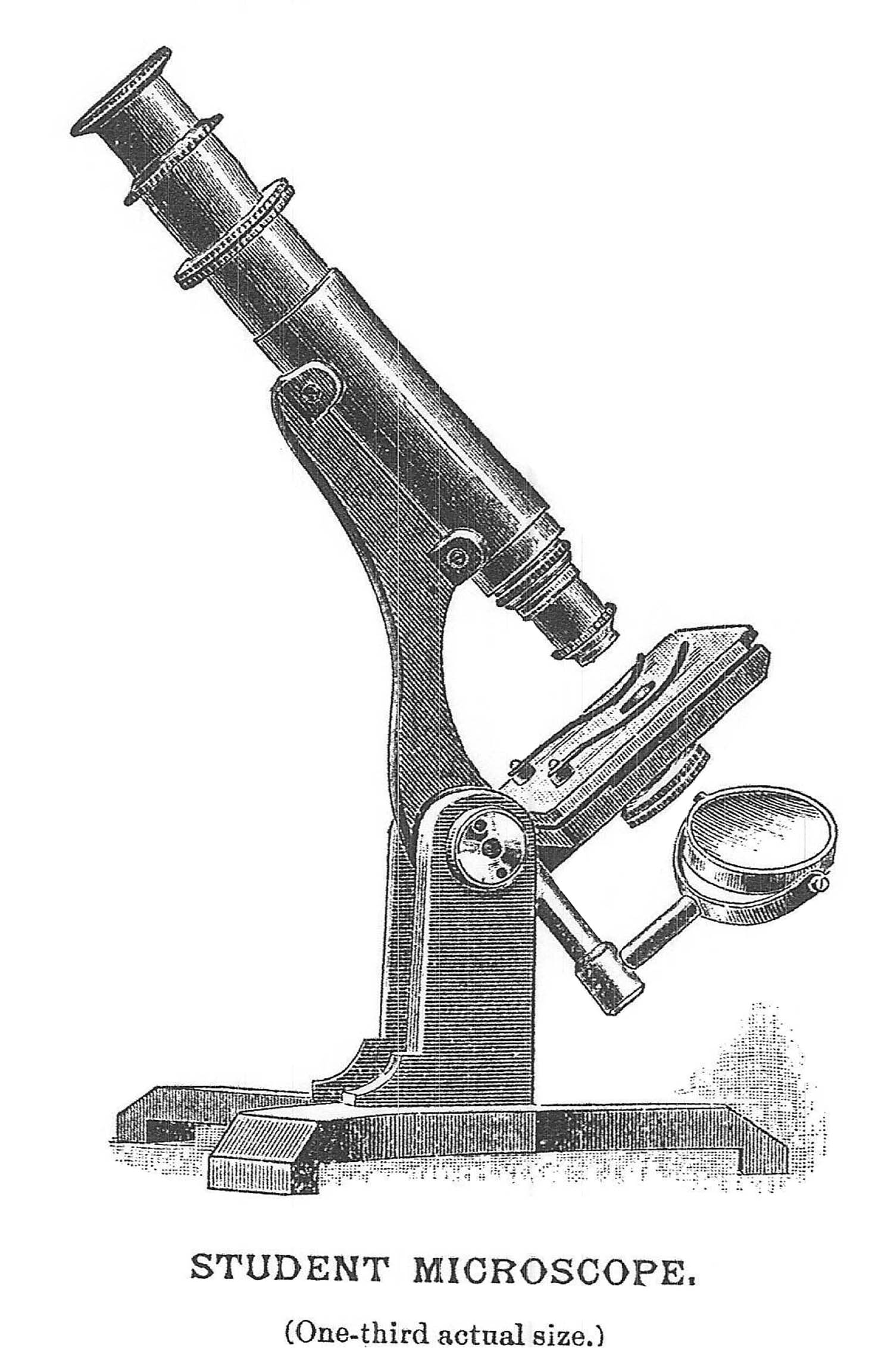 This simplest of all
known Bulloch stands, which replaced his 'New
Student' Model shown above, had coarse focusing by pushing or pulling
the main optical tube. This then was a much simpler and cheaper
instrument at less than half the cost of the 'New Student' ($14 vs $30
with one eyepiece). The limb inclines between uprights arising directly
from, and cast into, the foot. Fine focus was by a fine screw
tilting
the stage. There was a wheel of apertures attached to the underside of
the plain stage. The concave mirror could swing over the stage for
illuminating opaque objects. It had a draw tube. Again, I
have yet to find an example.
This simplest of all
known Bulloch stands, which replaced his 'New
Student' Model shown above, had coarse focusing by pushing or pulling
the main optical tube. This then was a much simpler and cheaper
instrument at less than half the cost of the 'New Student' ($14 vs $30
with one eyepiece). The limb inclines between uprights arising directly
from, and cast into, the foot. Fine focus was by a fine screw
tilting
the stage. There was a wheel of apertures attached to the underside of
the plain stage. The concave mirror could swing over the stage for
illuminating opaque objects. It had a draw tube. Again, I
have yet to find an example.
THE PHYSICIAN'S, (1880'S-1891)
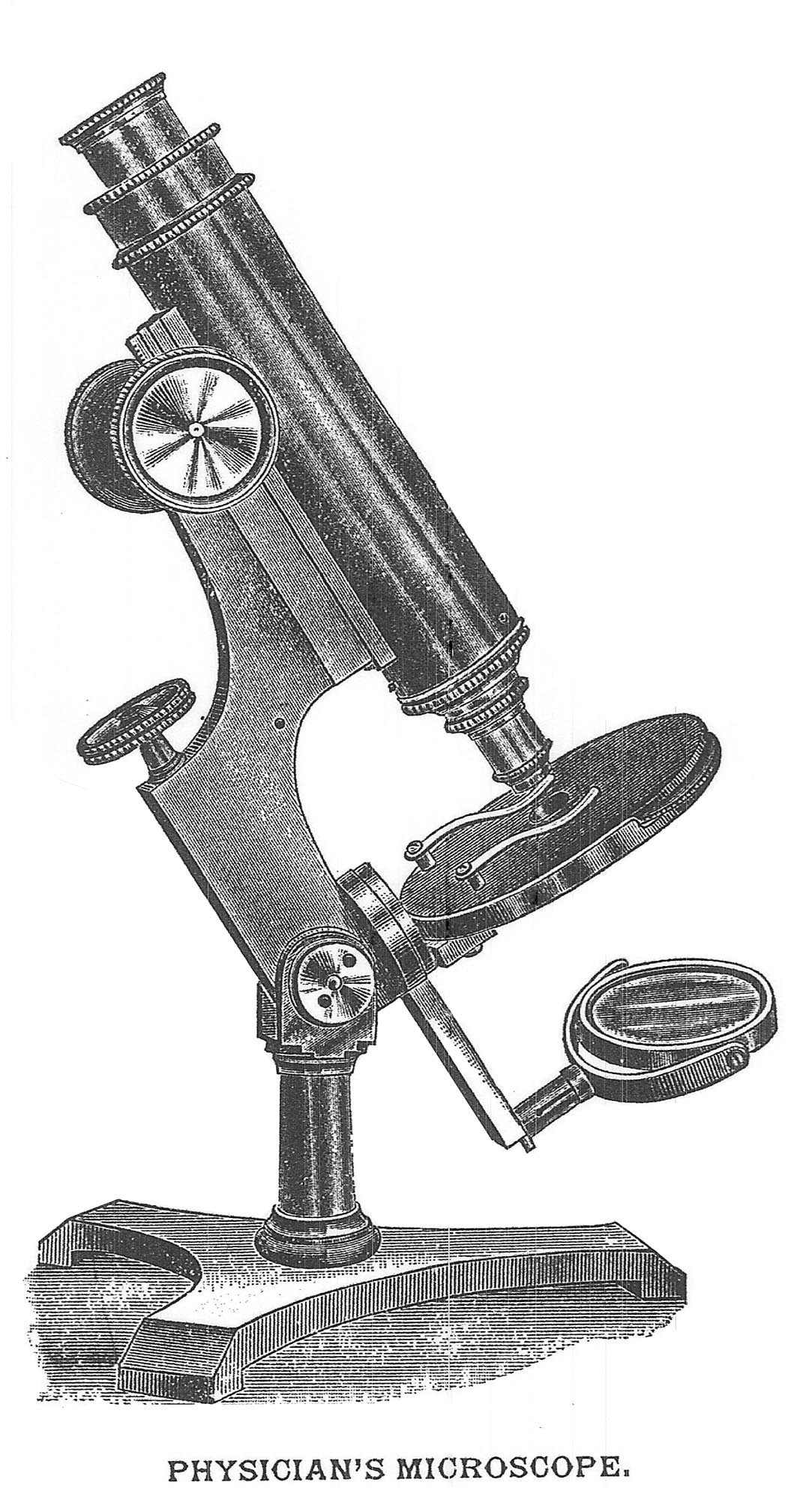 This
all brass instrument is slightly larger than the Histological No 2. The
foot was a flat tripod with one of the feet longer than the other two.
Like the Histological No 2, coarse focus by rack and pinion, fine by
long lever screw. The plain stage had a wheel of apertures on its
underside. The mirror was planoconcave, and could move up and down its
supporting tailpiece, as well as rotate above the stage for
illuminating opaque objects. Note however that the construction is
simpler than his more expensive stands with the axis of rotation not
isolated from the stage as there is no saddle piece.
This
all brass instrument is slightly larger than the Histological No 2. The
foot was a flat tripod with one of the feet longer than the other two.
Like the Histological No 2, coarse focus by rack and pinion, fine by
long lever screw. The plain stage had a wheel of apertures on its
underside. The mirror was planoconcave, and could move up and down its
supporting tailpiece, as well as rotate above the stage for
illuminating opaque objects. Note however that the construction is
simpler than his more expensive stands with the axis of rotation not
isolated from the stage as there is no saddle piece.
THE BASTIN-BULLOCH STAND (c. 1887-?)
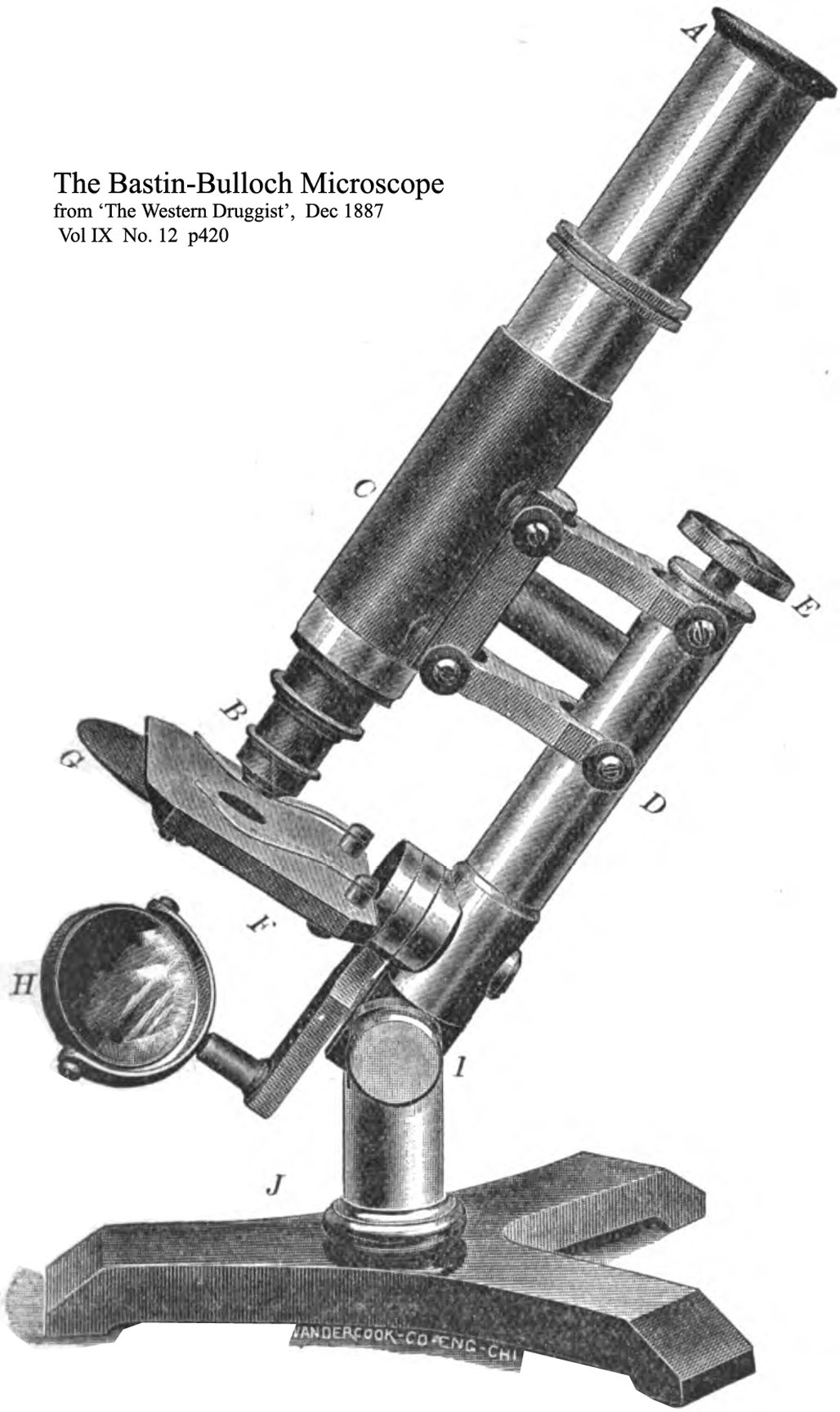 First pictured in The Western Druggist, Vol IX, 1887, this is one of
the Bulloch microscopes, like the 'New Student' stand which did not
appear in Bulloch's Catalogs. It was subsequently
noted in the American Monthly Microscopical Journal of February 1888,
and also in the Journal of the RMS. It combines the typical
Bulloch features of an asymmetrical Y-shaped foot and swinging mirror with axis
in the plane of the specimen, with the parallel linkage fine focusing
popularized by Gundlach, Seibert, Lietz, Zeiss and others. Coarse
focusing is by sliding the tube. There is a wheel of apertures disk
built into the underside of the stage. Like many of Bulloch's stands,
the mirror tailpiece can be rotated so that the mirror is above the
stage, to illuminate opaque objects. According to the 'Western
Druggist,' these scopes were 'manufactured on the order of the
publishers of the Western Druggist' which implies they were also the
distributors for these stands. This scope was supposedly developed for
pharmacognosists (pharmacists who worked with medicinal plants).
I have identified only one surviving example of this stand to date (as of 225).
First pictured in The Western Druggist, Vol IX, 1887, this is one of
the Bulloch microscopes, like the 'New Student' stand which did not
appear in Bulloch's Catalogs. It was subsequently
noted in the American Monthly Microscopical Journal of February 1888,
and also in the Journal of the RMS. It combines the typical
Bulloch features of an asymmetrical Y-shaped foot and swinging mirror with axis
in the plane of the specimen, with the parallel linkage fine focusing
popularized by Gundlach, Seibert, Lietz, Zeiss and others. Coarse
focusing is by sliding the tube. There is a wheel of apertures disk
built into the underside of the stage. Like many of Bulloch's stands,
the mirror tailpiece can be rotated so that the mirror is above the
stage, to illuminate opaque objects. According to the 'Western
Druggist,' these scopes were 'manufactured on the order of the
publishers of the Western Druggist' which implies they were also the
distributors for these stands. This scope was supposedly developed for
pharmacognosists (pharmacists who worked with medicinal plants).
I have identified only one surviving example of this stand to date (as of 225).
